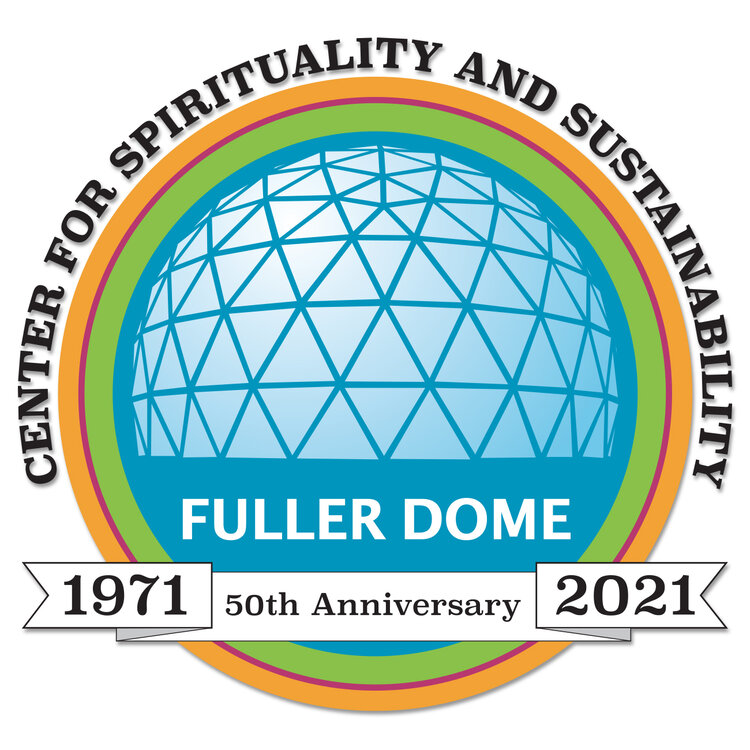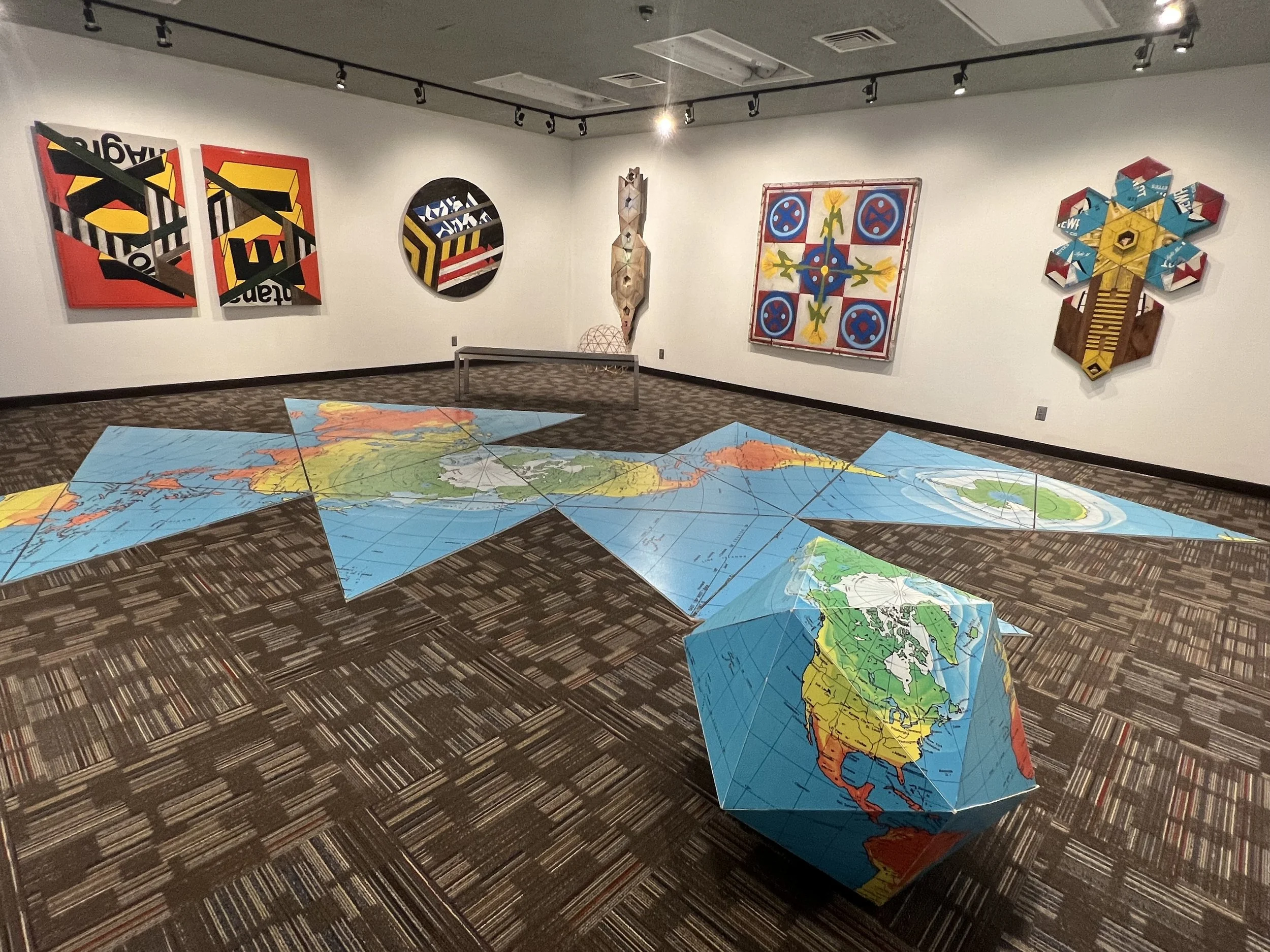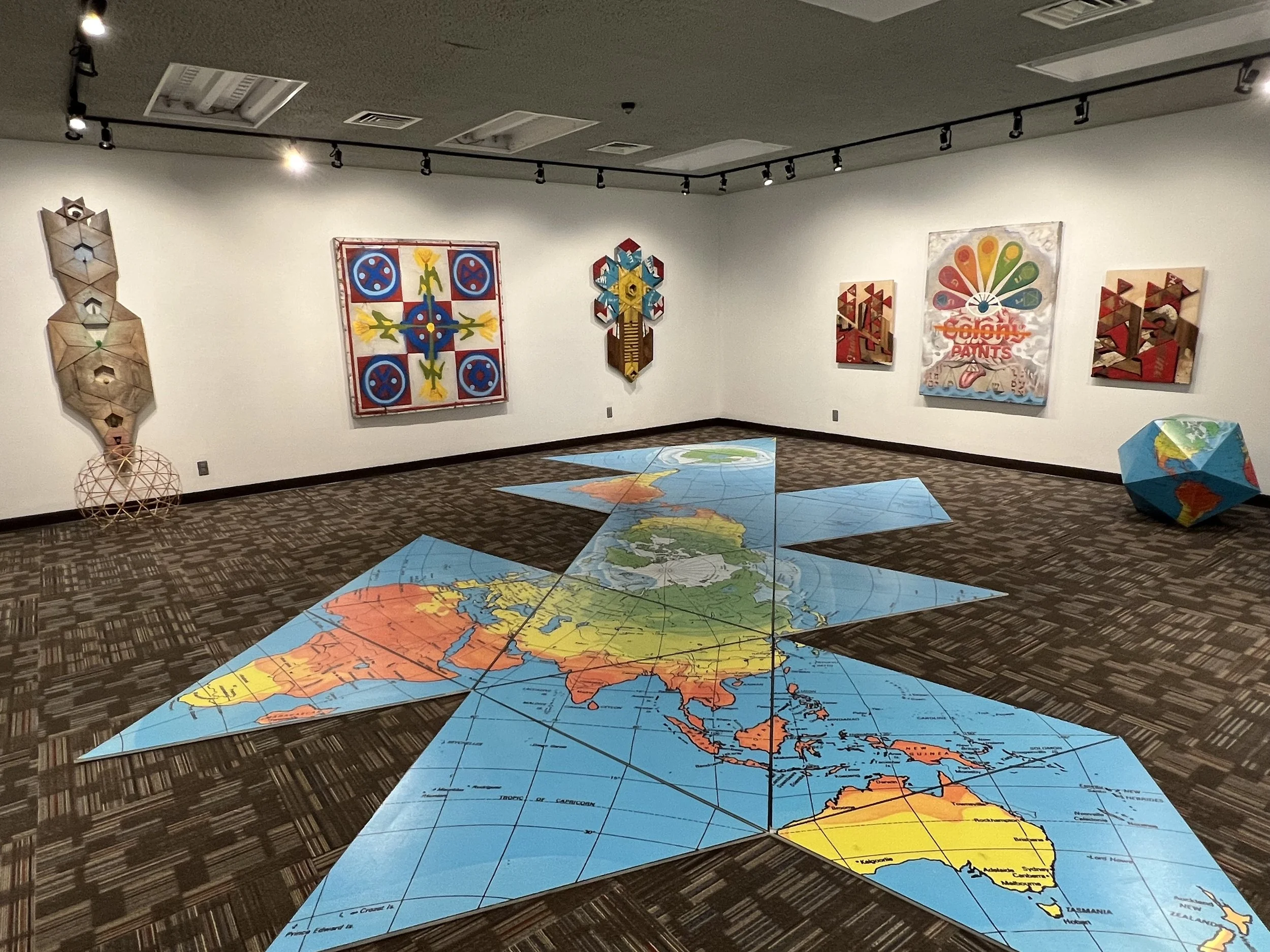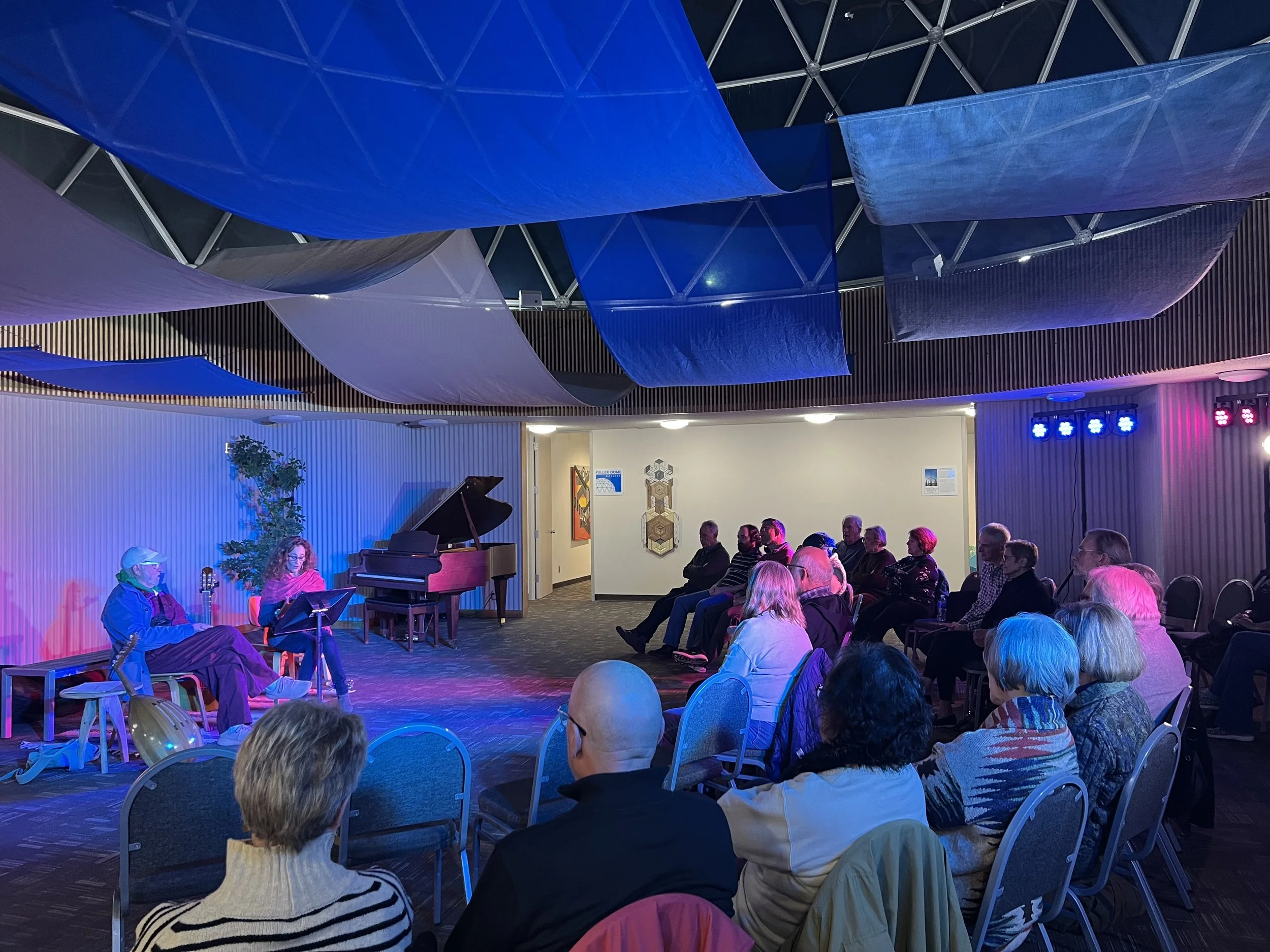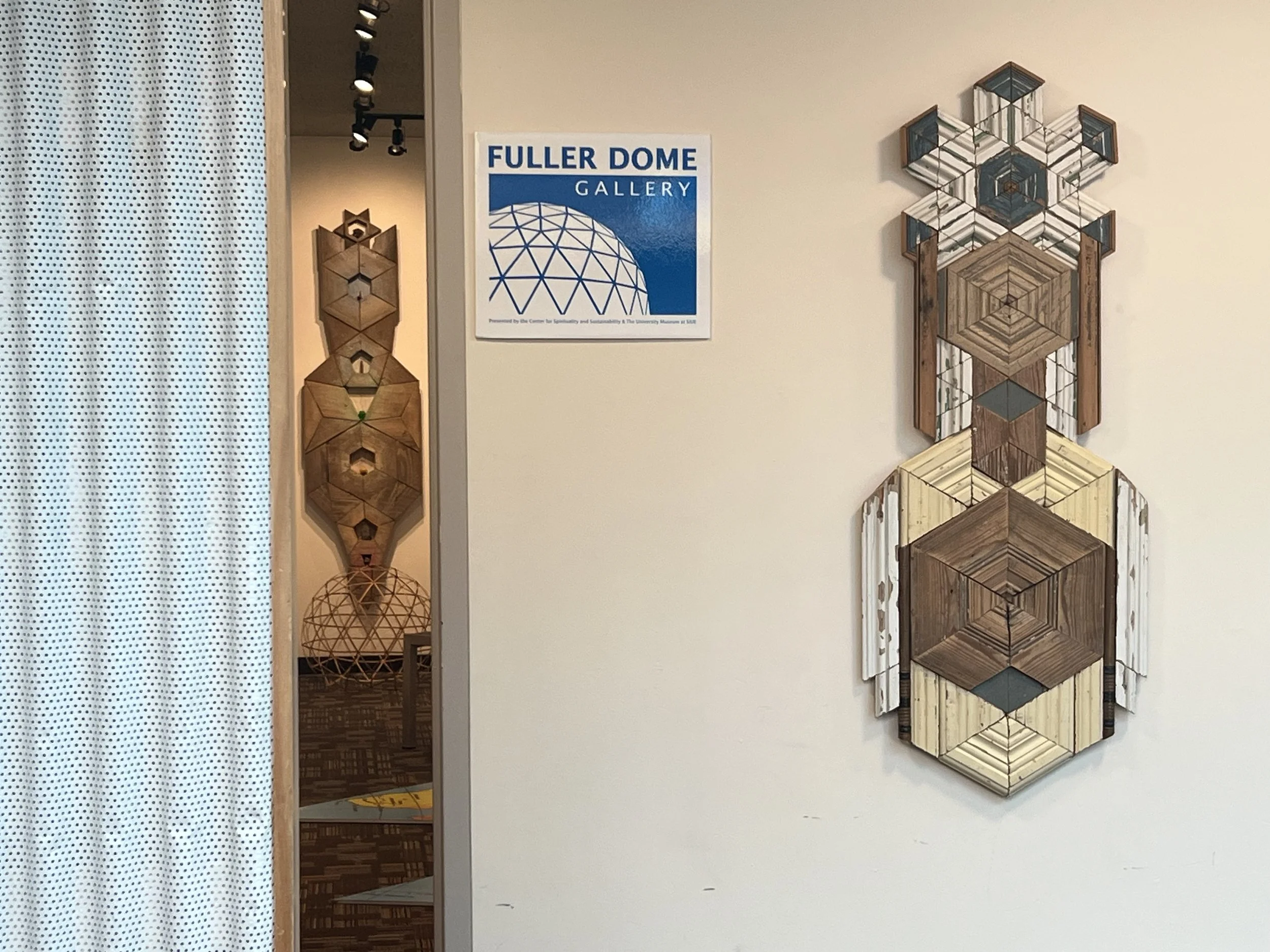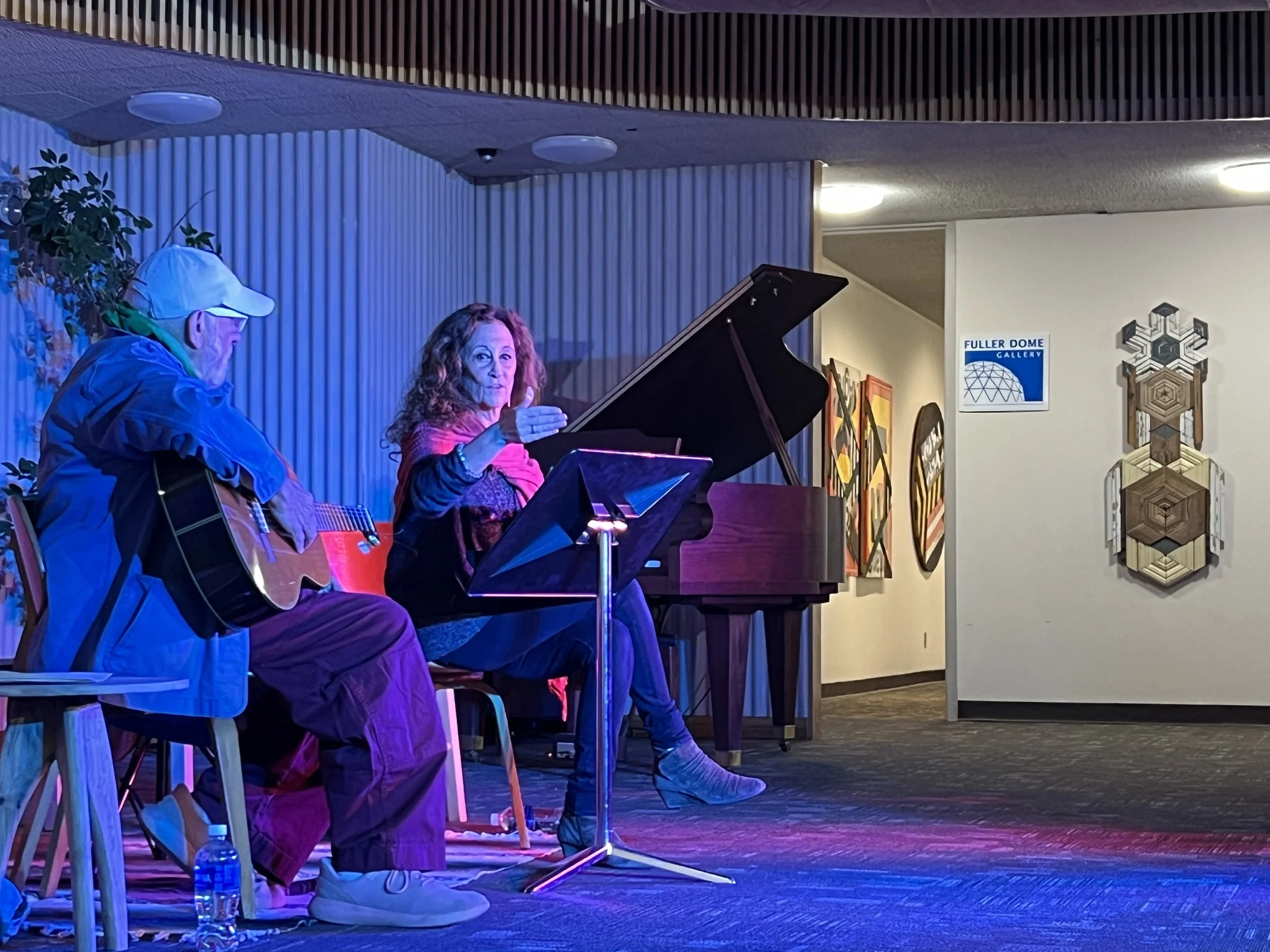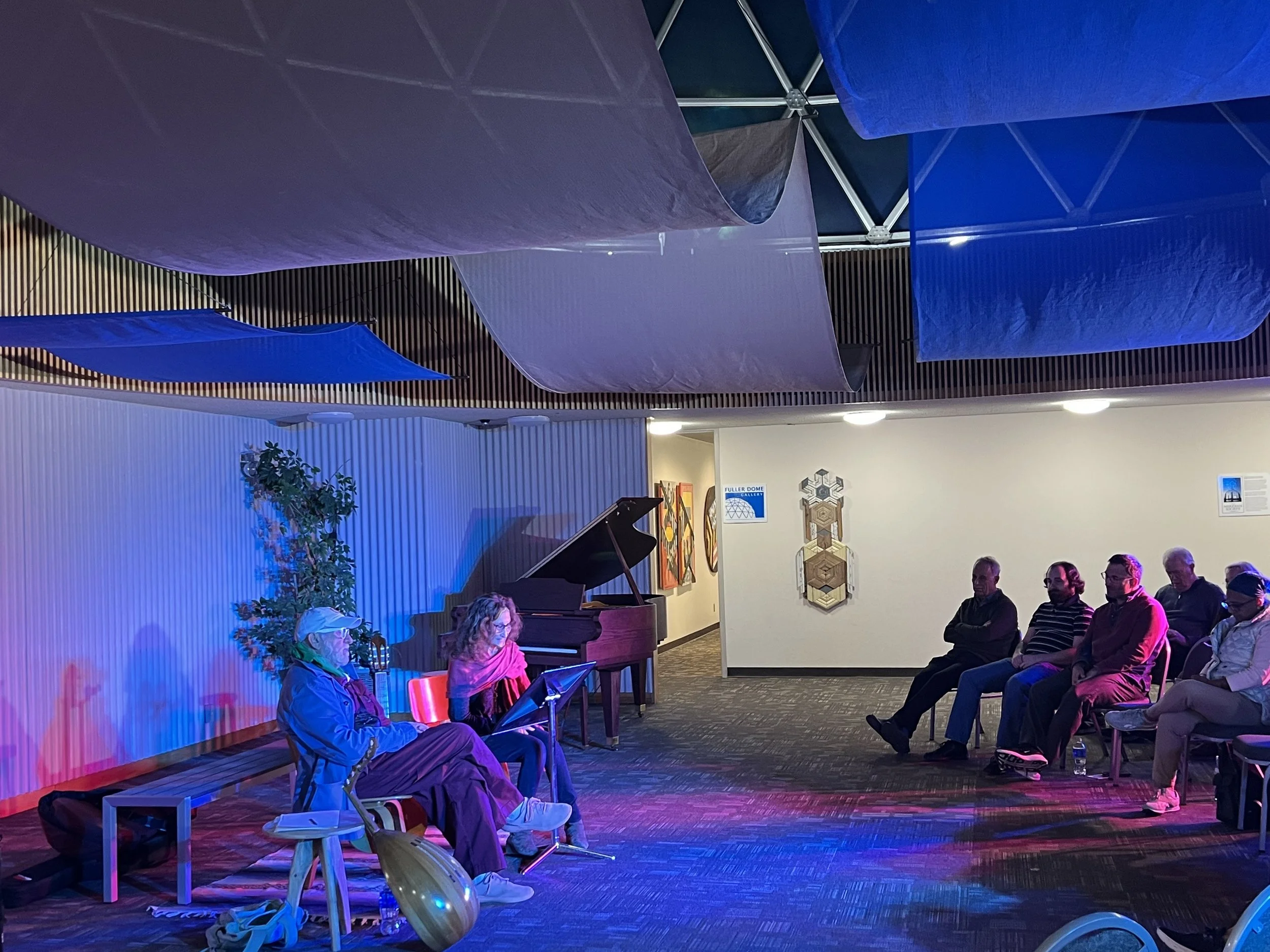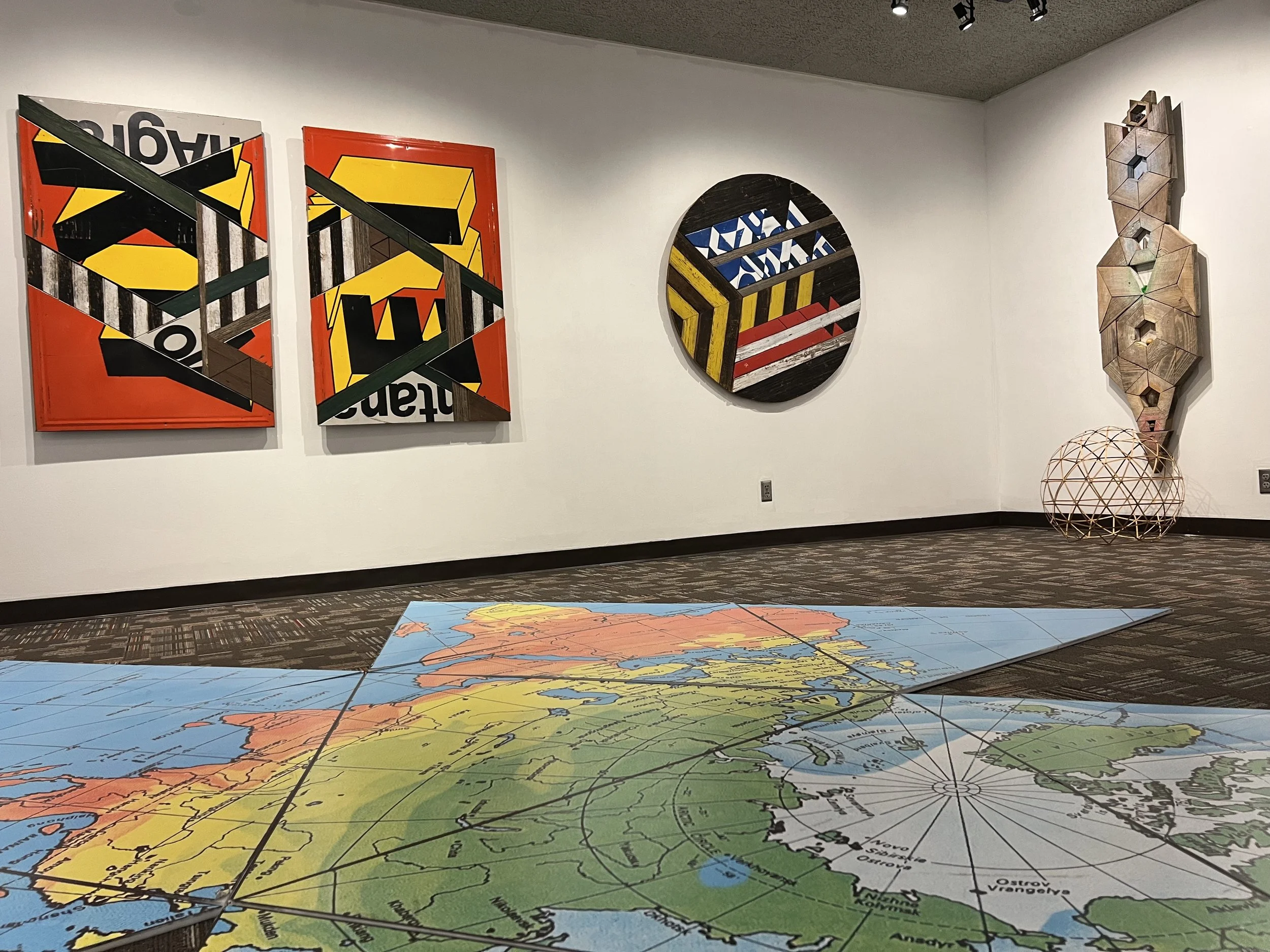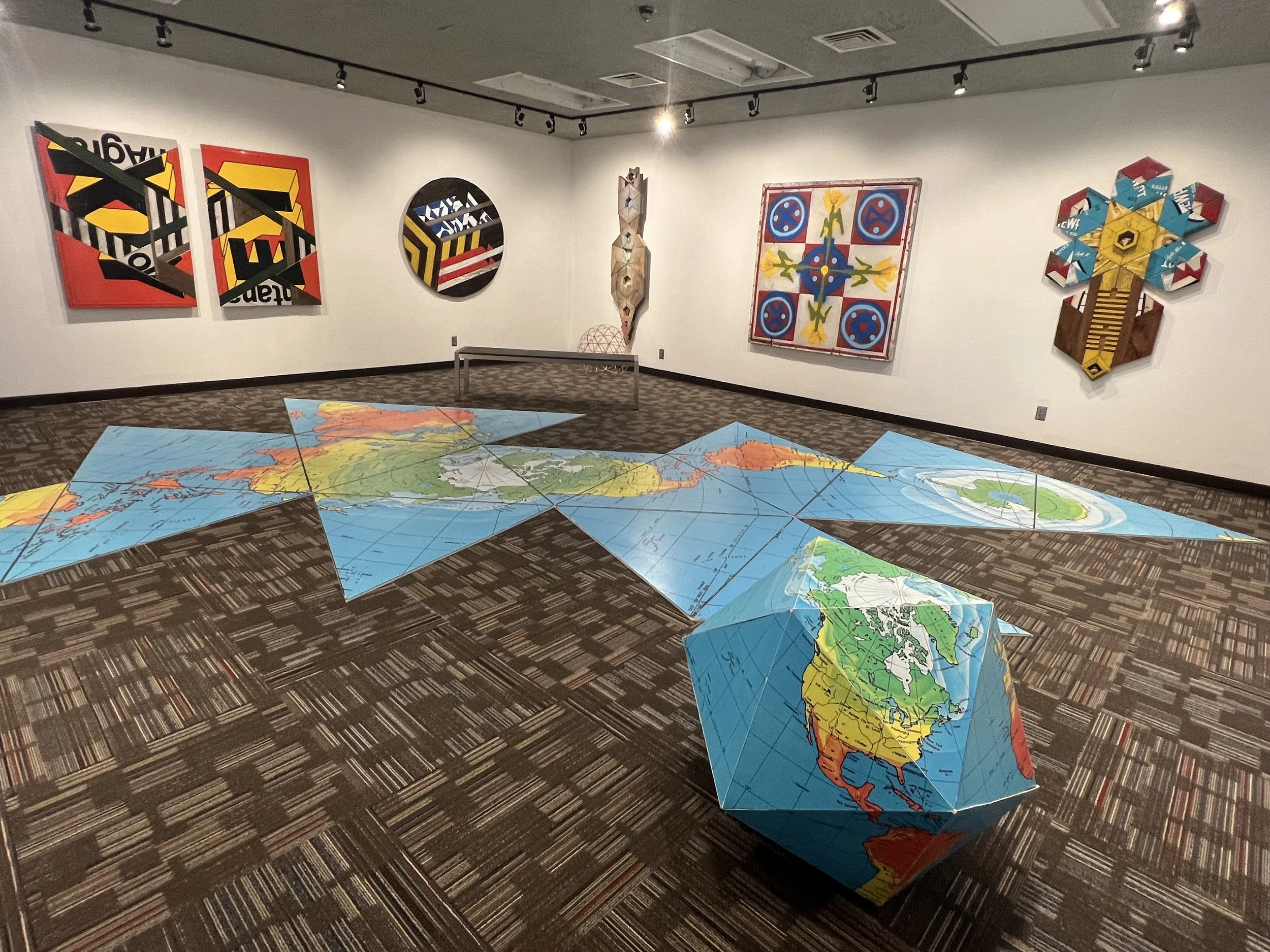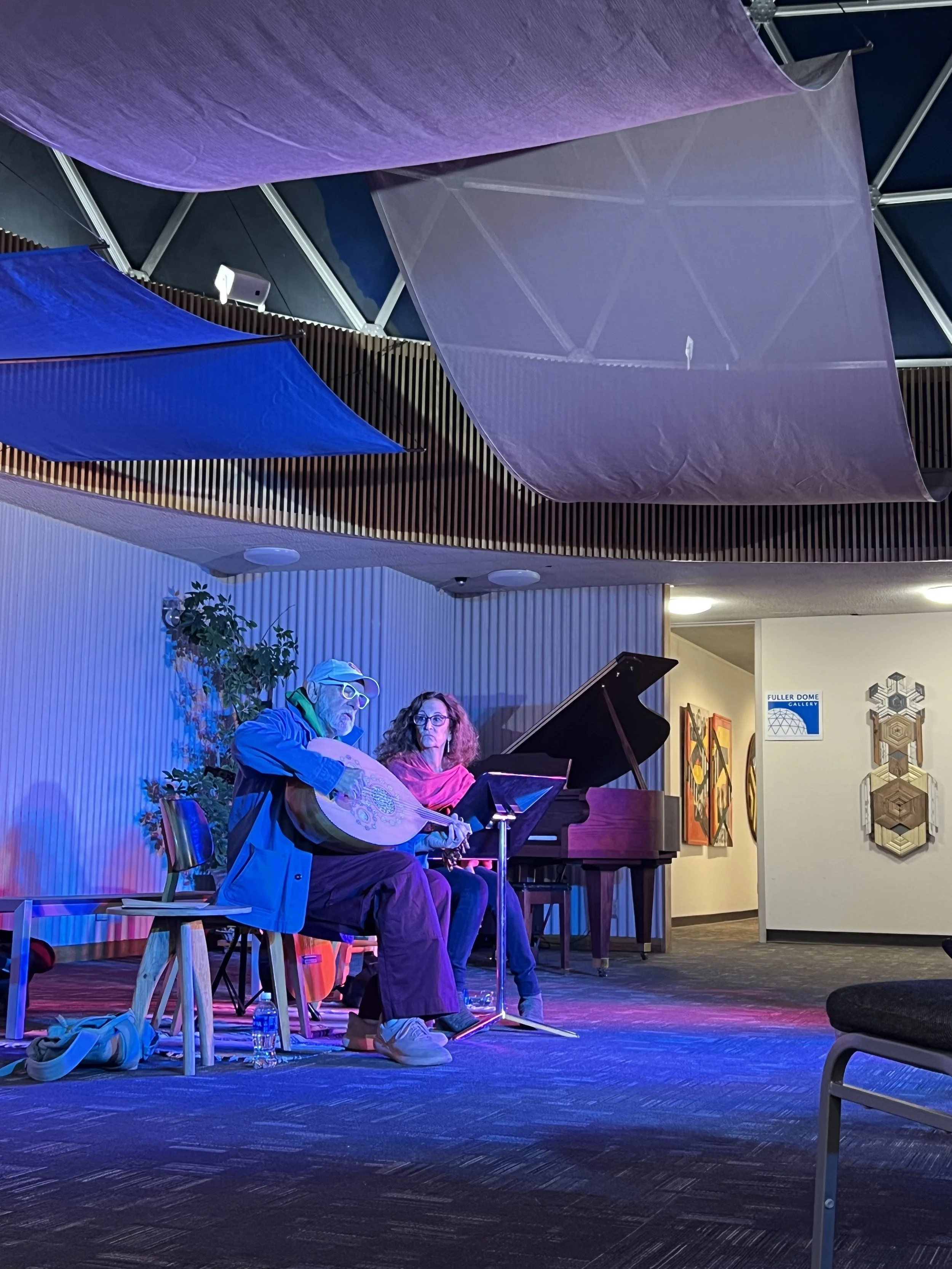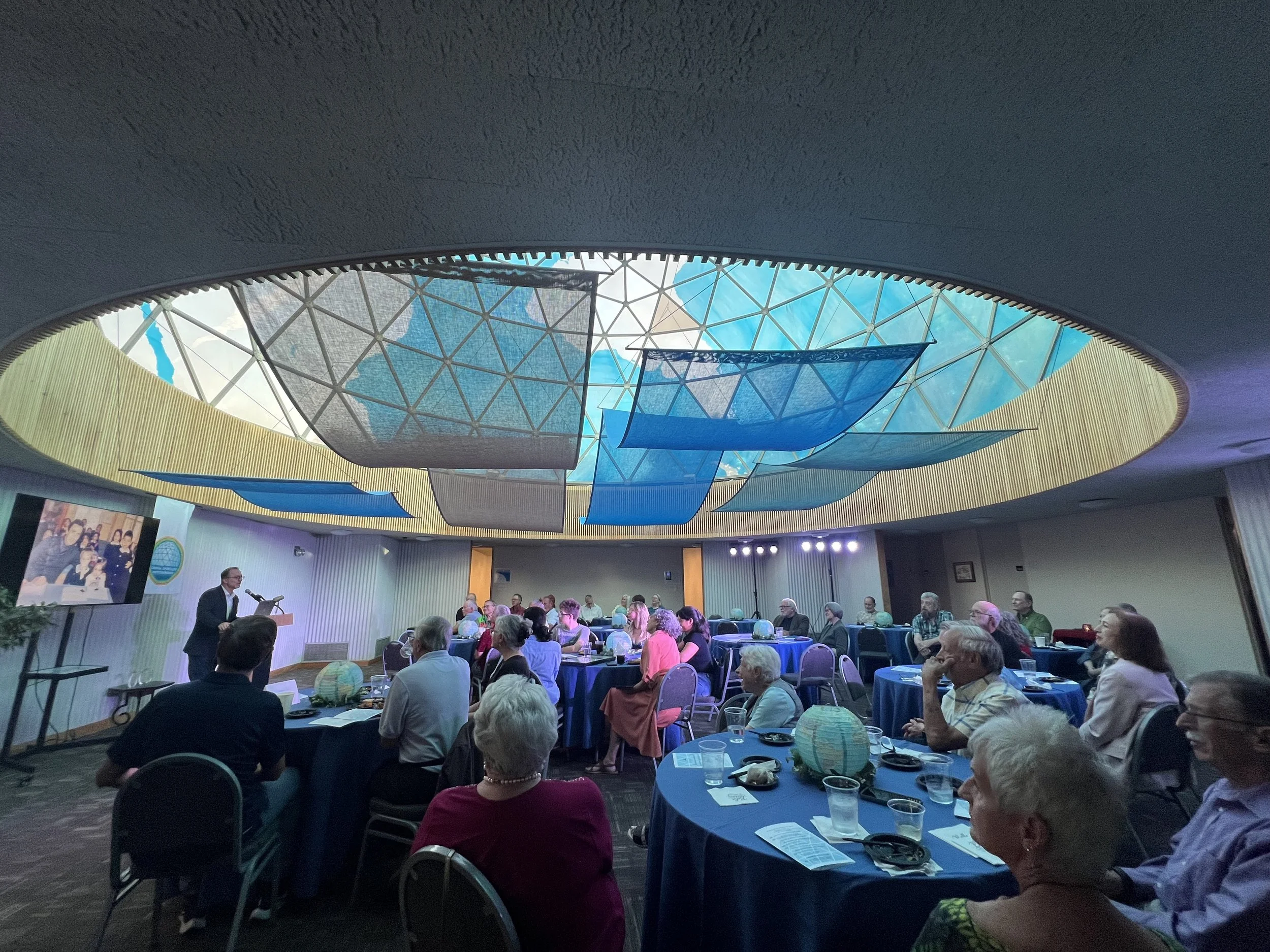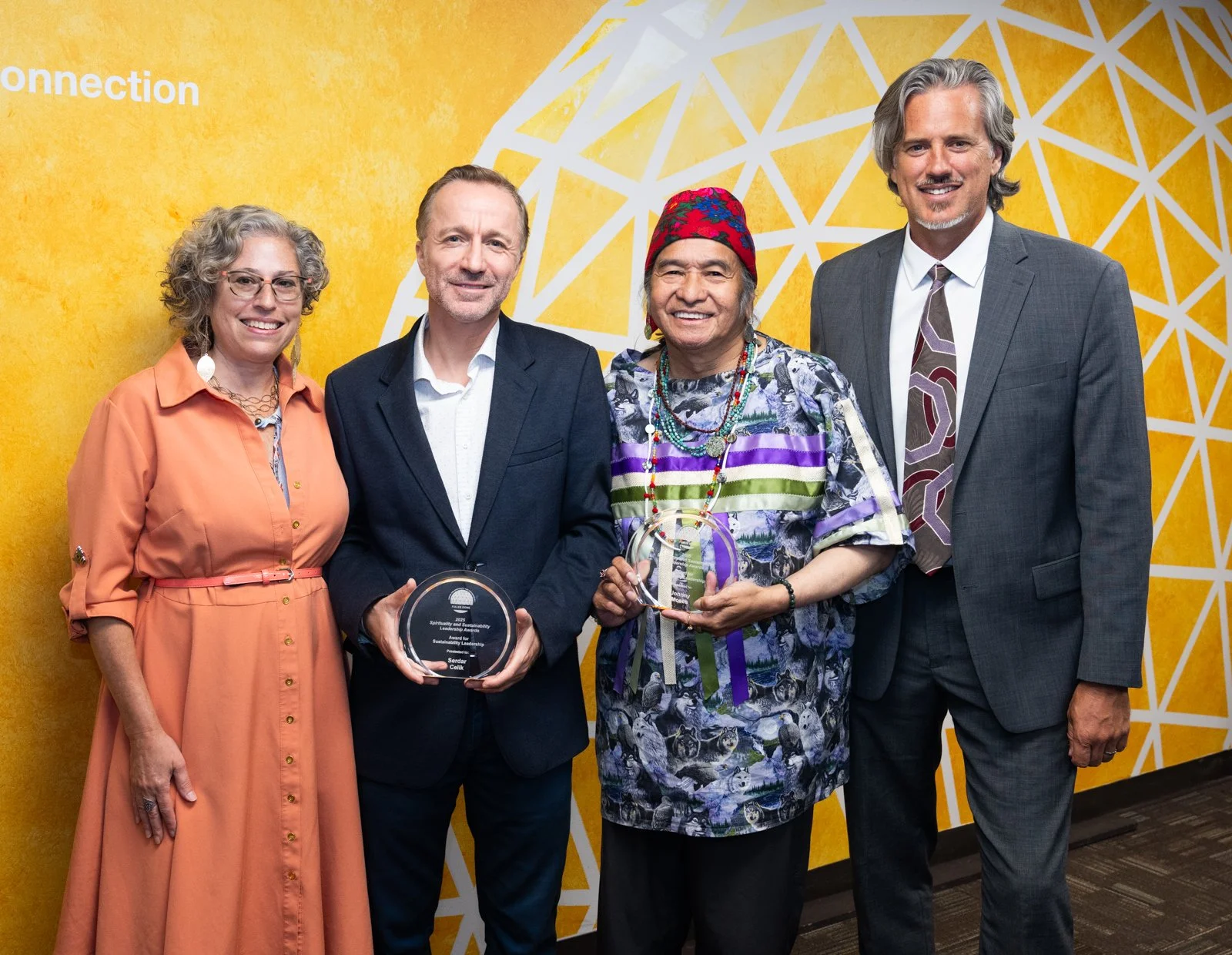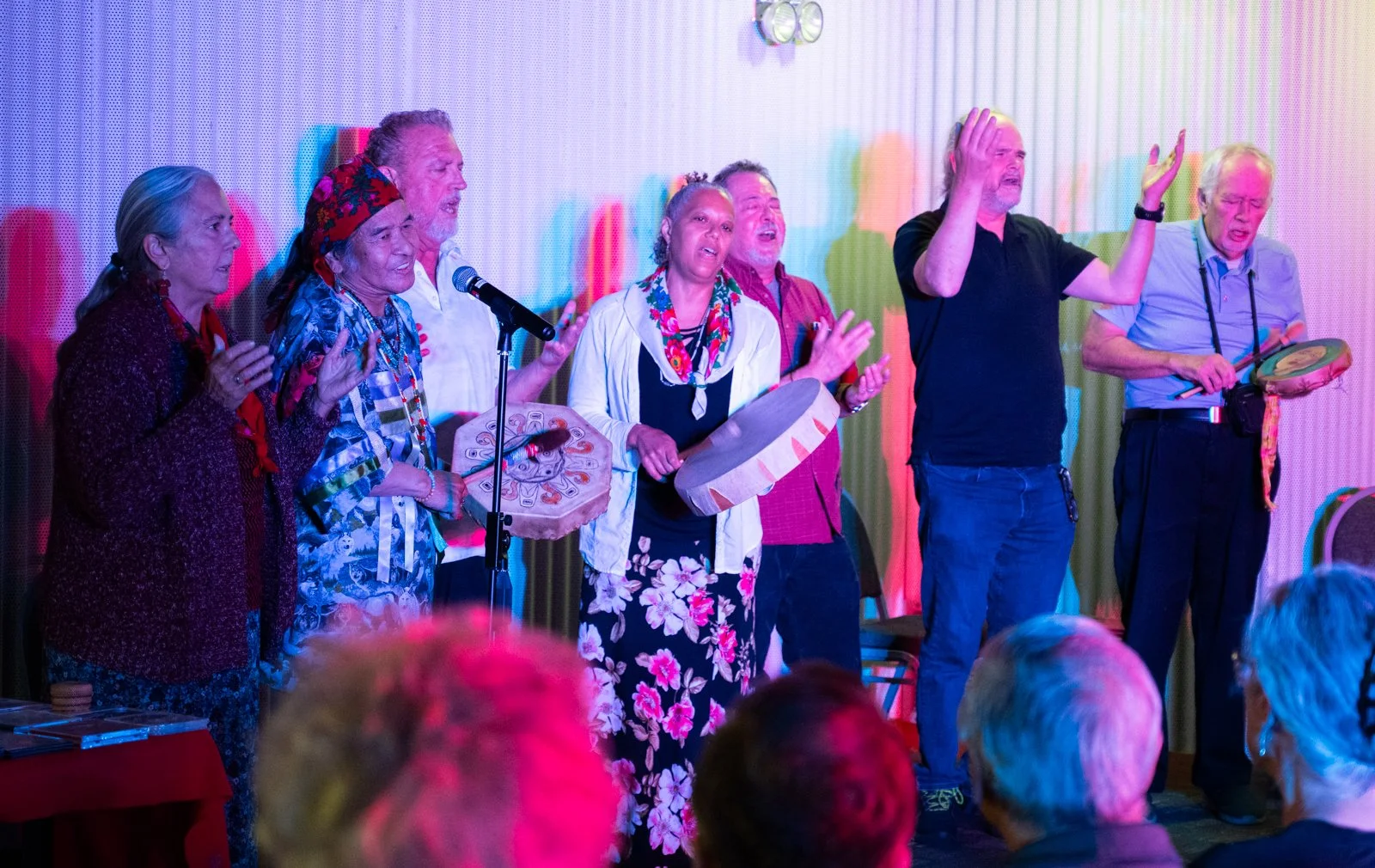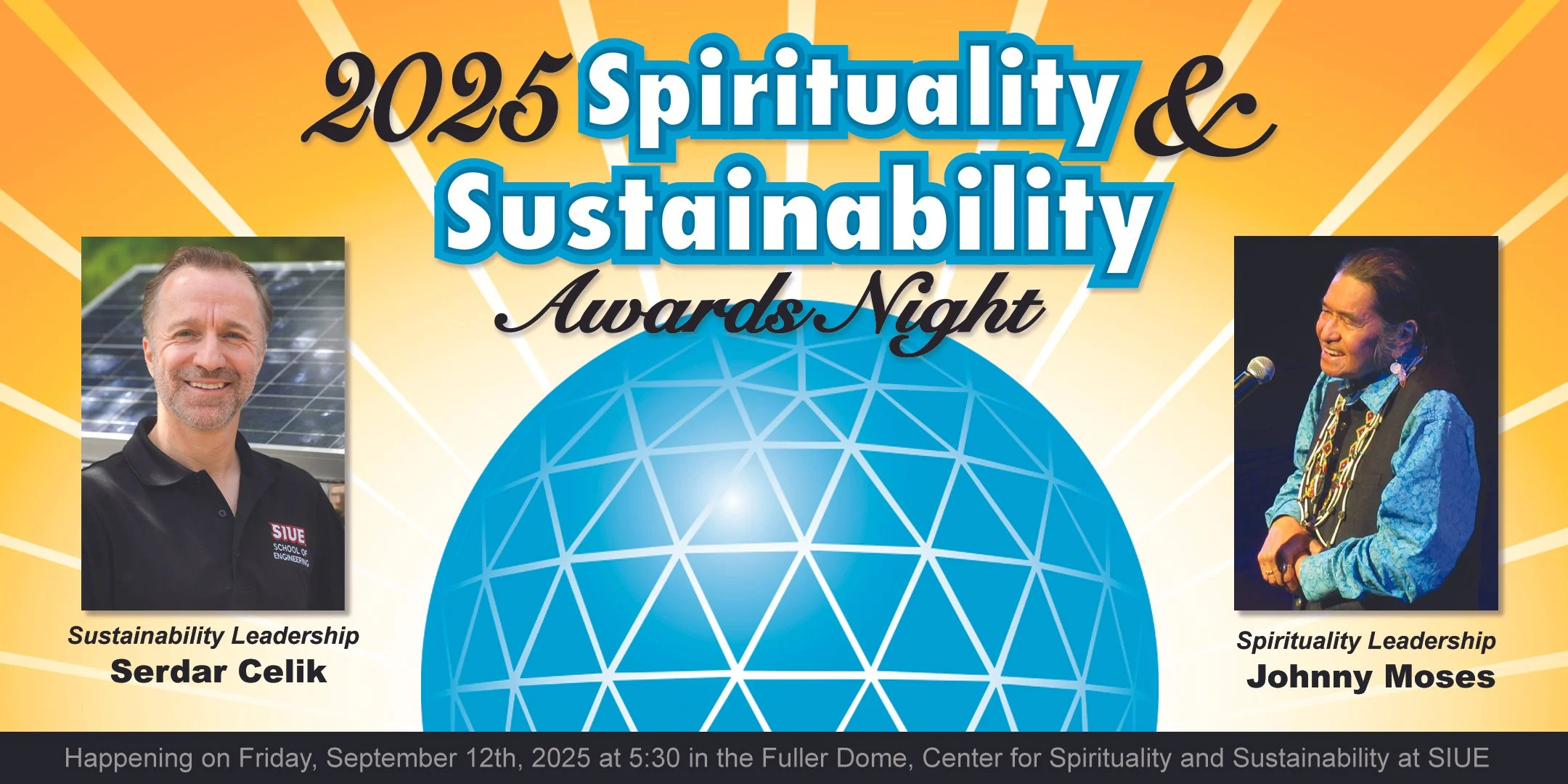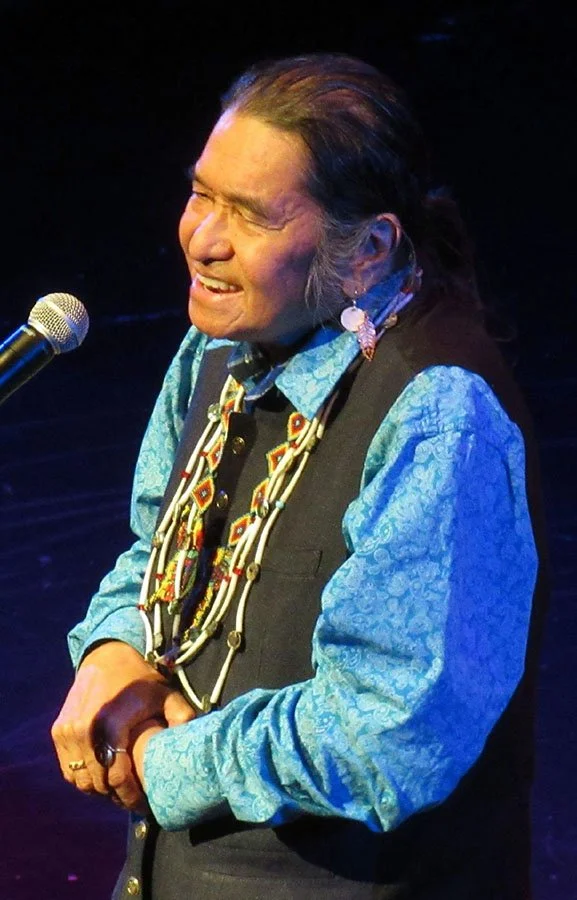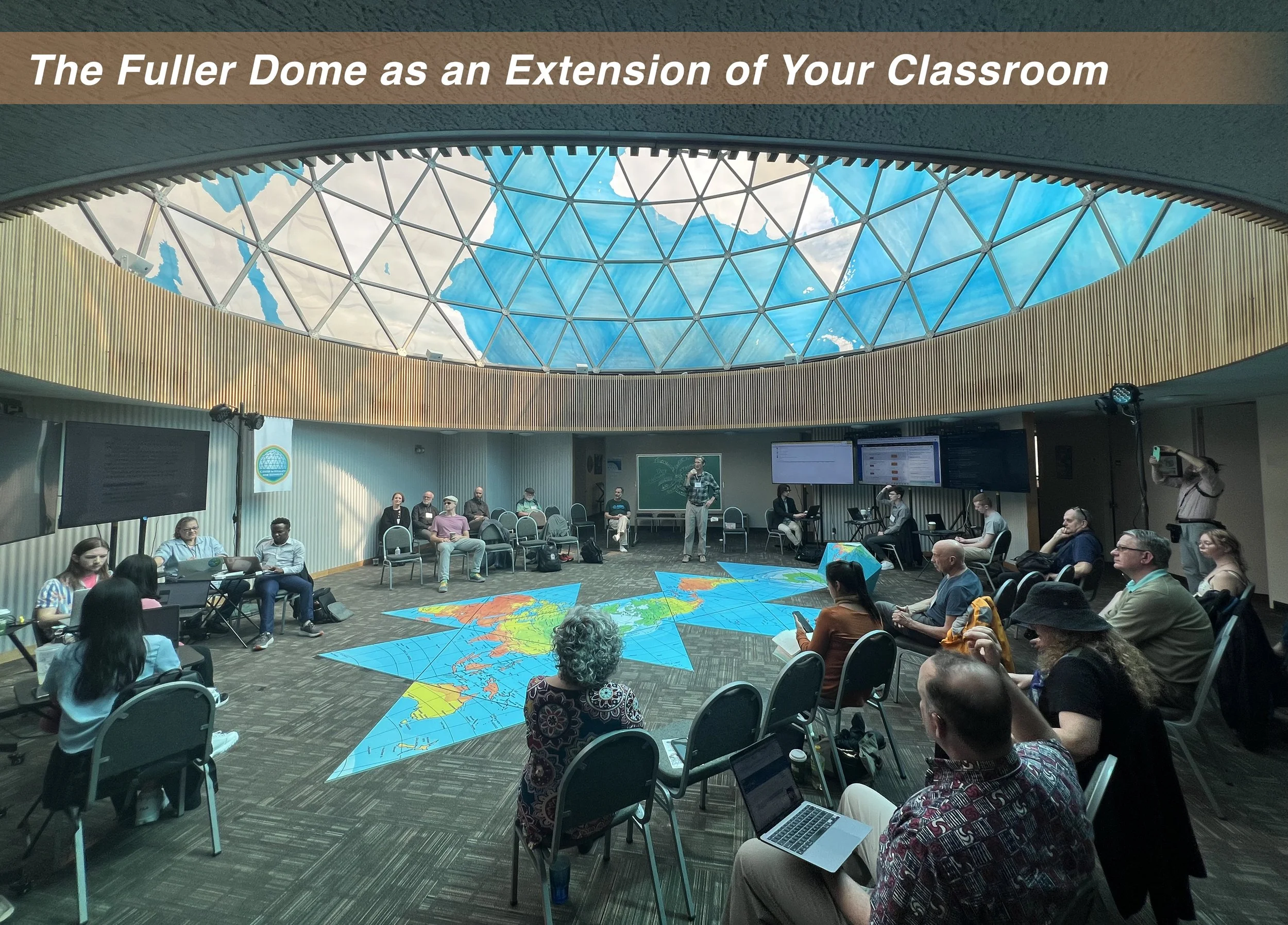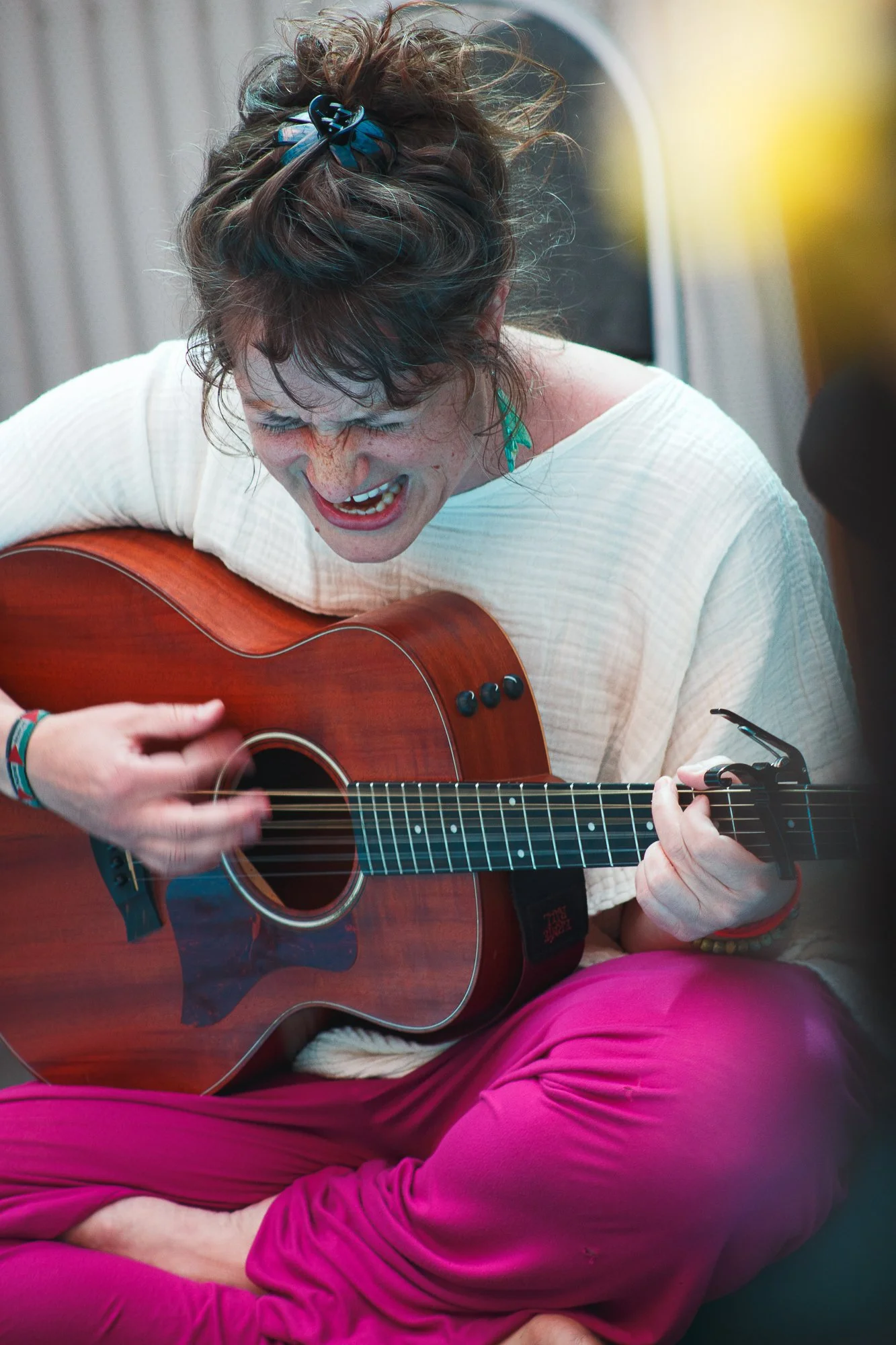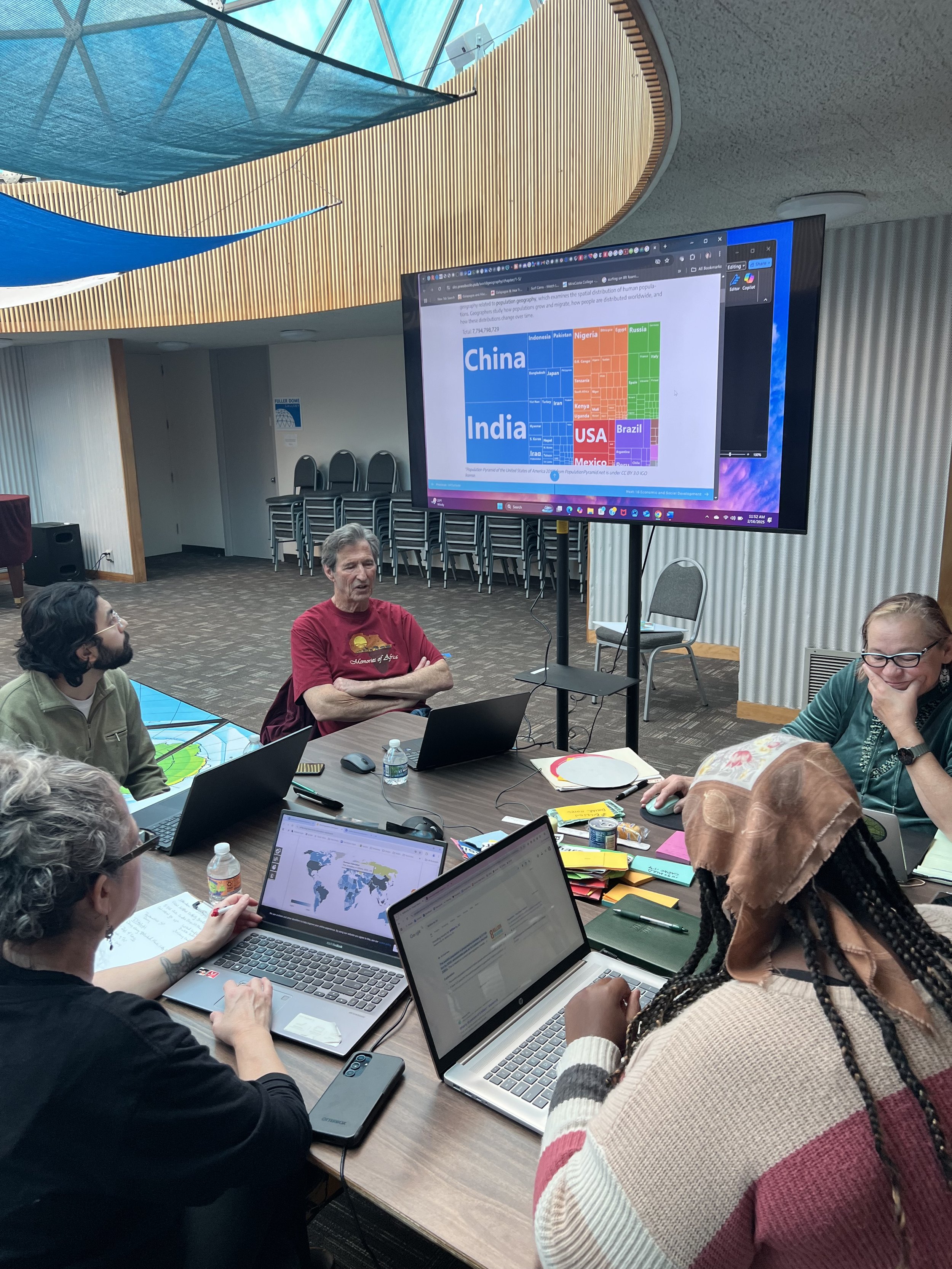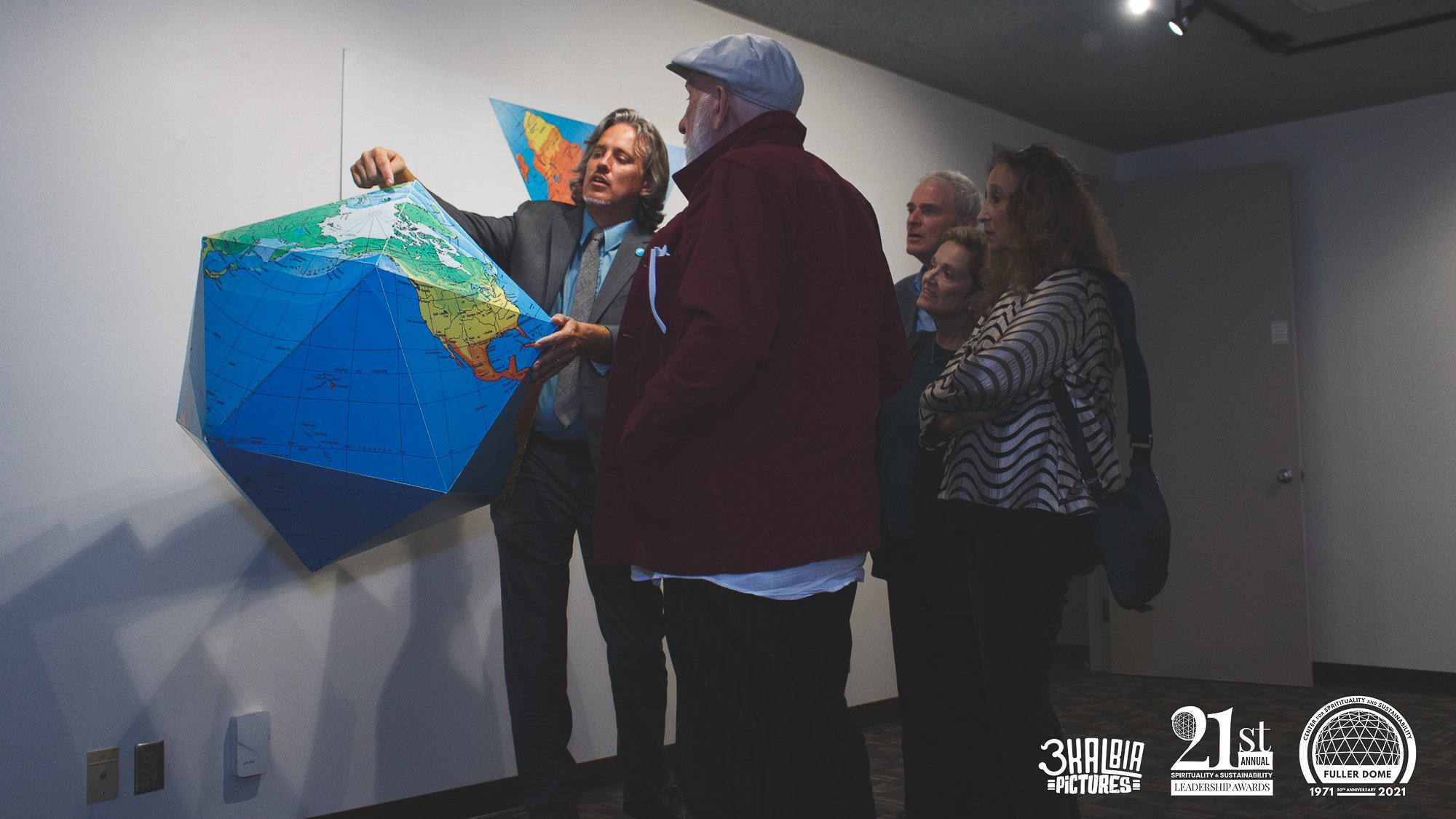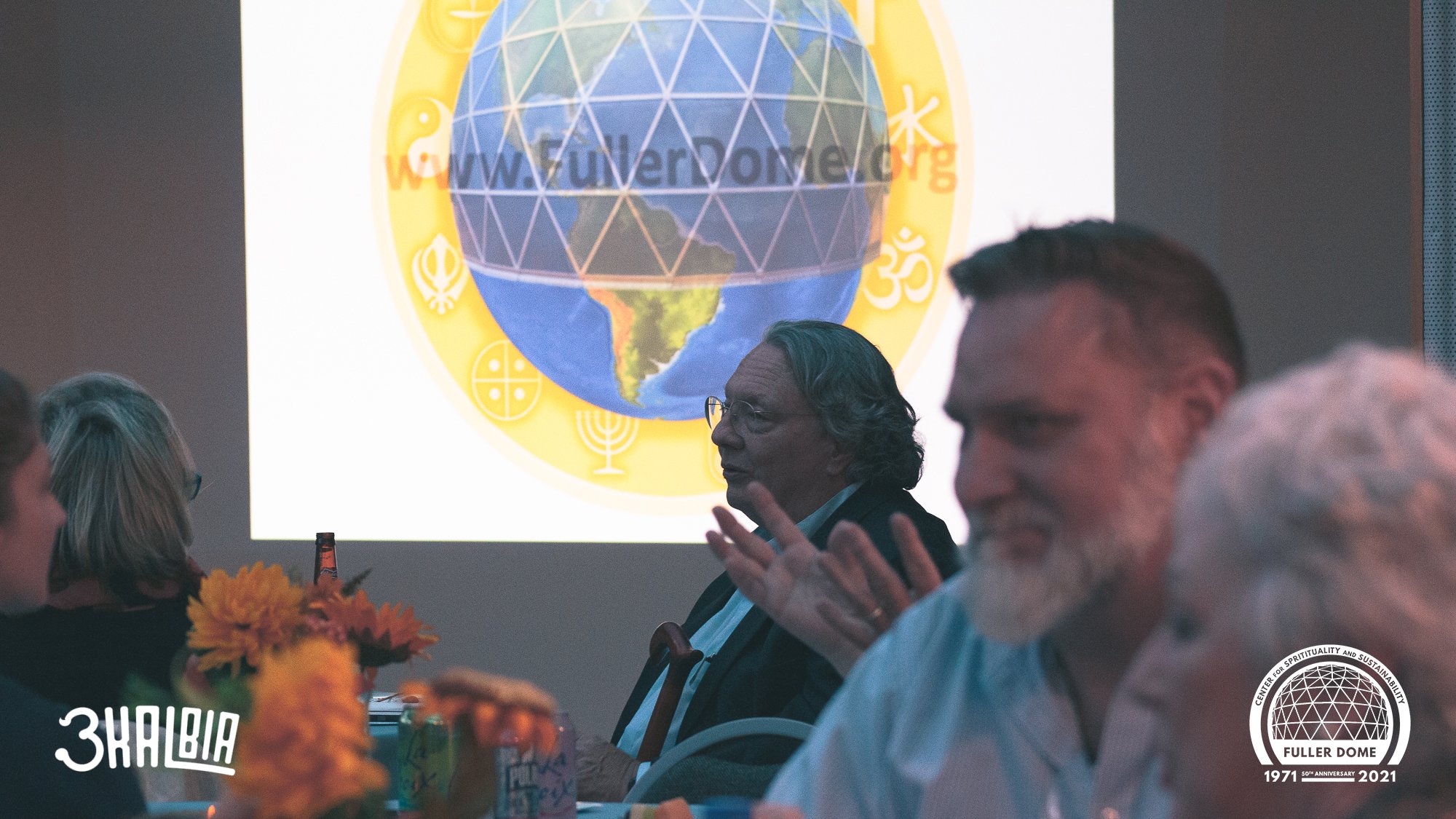As a continuation of the initiative launched in cooperation with the Buckminster Fuller Institute, Southern Illinois University and the Bucky Fuller Dome Home on the 90th Day of 2025 in the Fuller Dome miniature-earth Geoscope at SIUE, we are now headed to Carbondale in the Spring of 2026. Earlier this year we were able to reactivated several of Buckminster Fuller’s key concepts including the World Resource Simulation Center, The World Peace Game and the Geoscope as a package of programs that can be replicated on campuses across the world. Southern Illinois University at Carbondale is the first destination for this package of transformative programs reactivating Bucky’s legacy on University campuses. The call is open for proposals for the 2026 Fuller Futures Festival at Carbondale around the Earth Day holiday 2026. We will see you there.
"A New Language" Exhibition Artist Talk
Join Benjamin Lowder in the Fuller Dome Gallery for an artist talk on 11/21/25 at 7:00 PM
“A New Language” art exhibition by Benjamin Lowder in the Fuller Dome Gallery
“A New Language” launched on 10/24/25 with an evening of poetry, song, sacred story and visual art in the Fuller Dome with Rabbis Susan Talve and James Goodman. Accompanying the words and music was a visual art exhibition in the Fuller Dome Gallery by Benjamin Lowder featuring geometric assemblages built from reclaimed wood and vintage metal signage.
Lowder’s current series of work is titled, “Myth, Math & Magic.” This series is comprised of two- and three-dimensional totems constructed of reclaimed lumber and vintage metal signage. The advertising tropes of the vintage signs are deconstructed and reassembled into sacred geometric patterns that break the magic spell cast by the advertising’s original letterforms. These artifacts are recast to transmute feelings of nostalgia for an unsustainable past while drawing forward ancient wisdom to support an abundant future.
"A New Language"
“… for a new language of rising to the present for the sake of the future.”
On 10/24/25 Rabbis Susan Talve and James Goodman hosted an inspiring evening under the Fuller Dome, working the poetics of decency to lift up a dignified intention for better days ahead. “Some of our sources are from a universal language of adaptation from the past, some for a new language of rising to the present for the sake of the future. Together we can find a way forward with decency and dignity for all.”
Accompanying the poetry and music of “A New Language” the Fuller Dome Gallery opened an exhibition of visual artwork by Benjamin Lowder that also seeks a new language through transmuting the letter forms of vintage advertising.
An Evening of Inspiration • 2025 Awards Night
Thank you to all of you who supported and joined us under the dome for our annual Awards Night.
2025 Sustainability awardee Dr. Serdar Celik speaking in the Fuller Dome at Awards Night.
Each year the Center bestows two awards, one for Spirituality Leadership and one for Leadership in Sustainability. These dual awards reflect the Center’s mission to “promote humanity’s sacred connection to the Earth and each other.” This year the Fuller Dome was proud to honor the leadership of Johnny Moses and Serdar Celik whose careers embody the excellence, passion, leadership, and service that these awards were designed to recognize. The following photos are by Howard Ash:
L-R Tovia Black, Serdar Celik, Johnny Moses and Benjamin Lowder
Master storyteller, Johnny Moses singing with friends accompanied by the Red Cedar Circle of S.W. Illinois.
2025 Spirituality and Sustainability Awards
The 22nd Annual, Fuller Dome, Spirituality and Sustainability Leadership Awards, in Buckminster Fuller's miniature-earth dome on the SIUE campus.
Friday, September 12th from 5:30 - 7:30pm CDT. Doors open at 5pm.
The Center for Spirituality and Sustainability is hosting its annual Leadership Awards on Friday, September 12th, at 5:30 p.m. in the Fuller Dome on the campus of Southern Illinois University in Edwardsville, IL. This year the Fuller Dome is proud to be honoring the leadership of Johnny Moses and Serdar Celik whose careers embody the excellence, passion, leadership, and service that theses awards were designed to recognize. The doors will open at 5:00 with hors d’oeuvres and live music.
Each year the Center bestows two awards, one for Spirituality Leadership and one for Leadership in Sustainability. These dual awards reflect the Center’s mission to “promote humanity’s sacred connection to the Earth and each other.” The Center for Spirituality and Sustainability is a multifaith home for spirituality and sustainability efforts housed in the Buckminster Fuller designed, miniature-earth, dome on the SIUE campus. This is an important annual fundraiser for our organization. It is open to the public and tickets are $50 each. Registration is required for this event, please register by 9/05/25.
The 2025 Spirituality and Sustainability Leadership Award recipients are:
Johnny Moses
2025 Spirituality Leadership Awardee
Whis-stem-men-knee – Walking Medicine Robe (Nuu-chah-nulth and Coast Salish)
Johnny Moses is a traditionally trained Native American memorizer, singer, and master storyteller. He is a recipient of the Washington Governor’s Heritage Award. His collection of 80 songs from the Native Northwest was released in 2017 by Smithsonian Folkways Recordings.
Johnny has told stories, given presentations, and led song and prayer circles at the Fuller Dome every few years for three decades. Many individuals, of all ages, have learned from, and been uplifted by the words he has shared. In 1996, on his first visit, recordings were made that are included in his book, Sacred Breath: Pacific Northwest Medicine Teachings, Stories, and Epics, forthcoming in 2026 from the University of Nebraska Press.
Serdar Celik
2025 Sustainability Leadership Awardee
Dr. Serdar Celik is a professor in the Department of Mechanical and Mechatronics Engineering at Southern Illinois University Edwardsville (SIUE). Before his academic career, he has several years of experience in air-conditioning and refrigeration industries. His research fields include renewable energy, building energy efficiency, green roofs, HVAC, and alternative cooling technologies. Besides his publications and book chapters, he owns two patents on environmentally friendly refrigeration systems, for one of which he received Industrial Invention Award. In 2018, Prof. Celik was selected as the Paul Simon Outstanding Teacher-Scholar at SIUE. He is the Founding Chair of SIUE Energy Symposia. He is also the Chair of the Climate and Sustainability Advisory Board (CASAB) at SIUE. Celik is the author of “Sustainable Energy: Engineering Fundamentals and Applications” published in 2023 by Cambridge University Press.
The Fuller Dome is located on the SIUE campus just off of Circle Drive, next to Visitor Parking Lot B.
Immediately following the awards event at 8:00pm, our 2025 Spirituality Awardee Johnny Moses will present: “Stories from the First People of the Pacific Northwest” award night guests are encouraged to stay but they need to register for this additional free event at.
Master Storyteller Johnny Moses in the Fuller Dome at SIUE
Johnny Moses, Whis-stem-men-knee – Walking Medicine Robe (Nuu-chah-nulth and Coast Salish)
Johnny Moses is a traditionally trained Native American memorizer, singer, and master storyteller. In this presentation for all ages, he will share songs, stories, and teachings from Native American peoples of the Pacific Northwest.
Friday, September 12, 2025, 8:00PM • Stories from the First People of the Pacific Northwest
Sunday, September 14, 1:00PM • Medicine Circle: Songs and prayers. Bring your voice, drum or rattle!
Johnny is a recipient of the Washington Governor’s Heritage Award. His collection of 80 songs from the Native Northwest was released in 2017 by Smithsonian Folkways Recordings.
Johnny has told stories, given presentations, and led song and prayer circles at the Fuller Dome every few years for three decades. Many individuals, of all ages, have learned from, and been uplifted by the words he has shared.
This is his eighth visit to speak in the southern Illinois and St. Louis region. In 1996, on his first visit, recordings were made that are included in his book, Sacred Breath: Pacific Northwest Medicine Teachings, Stories, and Epics, forthcoming in 2026 from the University of Nebraska Press.
Fuller Dome as Extension of the Classroom
Play the World Peace Game
Join us under the dome on Saturday, October 4th for Buckminster Fuller's World Peace Game, a data driven simulation played out upon Fuller's enormous Dymaxion Map.
Participants will stand on a 27ft by 12ft version of Fuller’s world map representing our global population distribution across the continents. They will be assigned natural and technological resources corresponding to the populations they represent and tasked with figuring out ways to work together across the planet to avert conflict.
The game is intended to model solutions to realize Fuller’s goal “to make the world work for 100% of humanity in the shortest possible time through spontaneous cooperation without ecological offense or the disadvantage of anyone.”
This session takes place in two parts: 10:00 am – Noon and 1:00pm – 3:30 pm with a one hour lunch break from noon to 1:00. While a professor at SIU, Fuller conceived the World Peace Game to be played out on an enormous version of his, 1946 patented, Dymaxion Map.
Special Play Performance for Bucky's Birthday
On The 90th Day
On The 90th Meridian
The Fuller Dome, Center for Spirituality & Sustainability hosted guests from across the nation and around the world into the miniature-earth dome, that Buckminster Fuller built straddling the planet’s 90th Longitudinal Meridian, for five days of inspiring, challenging and transformative programs. The gathering culminated on the 90th Day, on the 90th Meridian with a symposium on Fuller’s legacy.
Photos by Blake Detherage
Five Days of Fuller in his Miniature-Earth Dome
Day One • Fuller Dome 90th Day Programs:
The Fuller Dome, Center for Spirituality and Sustainability kicked off an historic five day long gathering on Thursday, March 27th with a “Welcome Event.” Attendees from across the nation and around the world were invited to celebrate Buckminster Fuller’s legacy and discover the “history and mystery” of Bucky’s miniature-earth “Geoscope” dome that he built on the Southern Illinois University, Edwardsville campus in 1971 with his architectural partner Shoji Sadao. Folks who had traveled to gather in the dome from places such as Manila, Columbia, Canada, California and New York were welcomed into the space to reactivate some of Bucky’s most transformative concepts with five days of performances, lectures, games, analysis, model building, data visualization, dance, art and music. The five day gathering became as much an affirmation of the human spirit as it was a celebration of Bucky’s ideas and it had those who attended grappling with their role as human beings to address the challenges facing us as a species. Like Bucky, they were left asking themselves, “what a single individual could contribute to changing the world and benefiting all humanity."
Fuller Dome Director, Benjamin Lowder, welcomed attendees to the conference by sharing the building’s relationship to the 90th Meridian as well as the 90th Meridian’s importance to Bucky’s 1946 Dymaxion Map patent. Benjamin went on to describe the series of meaningful coincidences that allowed Bucky to build his miniature-earth translucent dome straddling the planet’s 90th Meridian decades after he had used that same meridian as the spine of his Dymaxion Map. An enormous version of the Dymaxion Map, created for the conference, covered the floor of the Fuller Dome aligning its 90th Meridian directly on top of the planet’s actual 90th Meridian. The map would serve as the stage for all of the programs as well as the game board for the playing of Bucky’s World Peace Game. For the first time ever, four of Bucky’s key data visualization tools were combined together in a single setting, the Geoscope, Dymaxion Map for the World Peace Game and the World Resource Simulation Center.
Fuller Dome Board President, Connie Frey-Spurlock, stepped onto the Dymaxion Map to welcome folks into the Fuller Dome as well as the Southern Illinois University system at large. In addition to her role as board president, Connie is the Director of SIU’s Successful Communities Collaborative and she recognized Bucky’s ideas as potential tools for building resilient and sustainable communities across the region. Connie was followed by the Fuller Dome’s Manager, Tovia Black, who spoke to the meaningful impact that the Fuller Dome has had on SIUE students who have found their way into that unique space over the years. Stuart Cowan, the Executive Director of the Buckminster Fuller Institute, then walked the 90th Meridian of the Dymaxion Map as he shared BFI’s important role in the creation and planning of the 90th Day Programs. Stuart also spoke of BFI’s mission to serve as a hub connecting thinkers and doers from across the globe who are working in their own unique ways to achieve Bucky’s goal of "making the world work for 100% of humanity in the shortest possible time through spontaneous cooperation without ecological damage or disadvantage to anyone.”
Continuing the “Welcome Event” that kicked off the conference, Stuart Cowan brought up Glenn Page who traveled from Portland, Maine to attend the programs. Glenn runs the Collaborative for Bioregional Action (COBALT) and he rose to speak of a BFI Design Lab project that he leads to create “The Living Atlas” that will allow for bioregional visualization and scenario building. Glenn brought up one of his key collaborators in this effort who traveled to the Fuller Dome from Columbia, Juliana Bohorquez. Juliana built a geodesic dome herself in a beautiful setting on the Columbian countryside. She uses her dome as a connecting place and a sacred space to honor the land and to collaborate with folks from around the world engaged in sustainability efforts.
Stuart Cowan, BFI Executive Director, speaking at the Fuller Dome 90th Day programs “Welcome Event”
The enormous Dymaxion Map’s presence on the floor of the Fuller Dome; expressing a more accurate two dimensional picture of the world, with it’s 90th Meridian spine atop the actual 90th Meridian, laid out beneath a translucent miniature-earth that Bucky also designed to align with the 90th Meridian resulted in a fractal-like echo that untied the past with the present, the individual with the whole, as well as the microcosm with macrocosm. As Bucky said, the miniature-earth Fuller Dome straddling the 90th meridian provides "a sense of orientation of each human individual within the profound magnificence of Universe … allowing one to go inside to go outside one's self and into the center of the Earth and thence outward to the stars in seconds".
Day one of the 90th Day Programs continued with an architectural tour covering the most important region in the world for domes connected to the legacy of Buckminster Fuller. Attendees boarded the bus in the rain for a guided architectural tour beginning at the Fuller Dome that Bucky built on the SIUE campus 1971. The tour then traveled North a few miles up the Mississippi River to Wood River Illinois to drive into the Union Tank Car dome built in 1960. This 380ft wide 120ft tall geodesic dome is still in use today and is now under the ownership of Watco. The bus was met by Watco manager Kim Gardner who graciously shared a bit of the dome’s history as well as how the dome is currently being used by Watco. Next the tour crossed the Mississippi River and headed towards St Louis to visit The Climatron dome at the Missouri Botanical Gardens. It is a glass geodesic domed greenhouse built in 1960 to house a variety rare tropical plant species. The tour then came back across the river into East St Louis to visit the Mary Brown Center dome. Built in 1968, this laminar style dome is the meeting site for Bucky’s Old Man River’s City proposal of a mile wide domed city for East St Louis. Famed Afro-Caribbean modern dancer and activist, Katherine Dunham had reached out to Bucky in the 1960’s for a new urban plan for East St Louis and the one mile wide domed city called Old Man River’s City was the solution Bucky provided in collaboration with James Fitzgibbon and a team of Washington University architectural students. From there the tour returned to the miniature earth Fuller Dome on the SIUE campus.
After the architectural tour, the Fuller Dome was set to host a Katherine Dunham style dance performance created by Vivian Watt and her NIA Entertainment dancers. Vivian Watt choreographed this 90th Day dance program to be performed upon the Dymaxion Map under the dome and it provided powerful resonances as she and her dancers moved across the continents occasionally reaching down to touch the land acknowledging our sacred connection to Mother Earth. The dance also honored the connection between Bucky and Ms. Dunham, as it was Katherine Dunham who had collaborated with Bucky on the Old Man River’s City concept for East St Louis. Vivian Watt trained with Ms. Dunham at the East St Louis Katherine Dunham Performing Arts Center from 1975 to 1980. Vivian was elevated to the position of “Principal Dancer” during that period and she went on to perform Dunham style dances across the country.
Vivian Watt, choreographer and Katherine Dunham Performing Arts Center Principle Dancer from 1975 to 1980
In the Beginning There Were Drums • and Bells • and More Drums • and Voices
Elam Ko Elam Bae - Elam Ko Elam Bae - Elam Ko Elam Bae - Elam Ko Elam Bae
And People • And the People Danced!
The Dunham style dance program began with a drum call and then transitioned through each member of Vivian’s company sharing their inspiring talent and unique style through powerful movement and rhythm. The energy of the program reached a crescendo with Vivian leading all those in attendance in a dance throughout the building and into the Fuller Dome Gallery to open the exhibition of Buckminster Fuller artifacts and a SIUE student project.
Vivian Watt leading attendees on a dance throughout the Fuller Dome during the first day of the 90th Day Programs
Once Vivian had led the dome’s guest into the Fuller Dome Gallery through a dance procession, the remainder of the first day of the 90th Day conference was spent viewing and learning about the exhibition of Buckminster Fuller’s artifacts in the gallery. The exhibition also featured an 8ft diameter model of the Fuller Dome built by a class of SIUE students for professor John Cabbages, construction management class. The working group of students were on hand to answer questions and would go into greater detail on their project in the symposium scheduled for the final day of the 90th Day programs.





Day Two • Fuller Dome 90th Day Programs:
Day 2, 3/28/25, of the 90th Day programs began with a reactivation of Buckminster Fuller’s World Resource Simulation Center concept. Peter Meisen of San Diego, California facilitated the session. Peter ran a version of Bucky’s World Resource Simulation Center idea for many years in San Diego. Peter called his version of this concept the “Sim Center.” The original version proposed by Bucky and his Director of Research and Development Thomas Turner, was to be two buildings built on the SIUE campus. Phase one of the project consisted of creating a 200’ wide domed theater in which to play the world game on a 100’ long Dymaxion Map. Phase 2 of the project would see the construction of a 400’ diameter five-eighths spherical dome with data presented on the inner surface of the dome. Although having an Illinois House of Representatives bill appropriating funds for the center’s construction in 1967, this ambitious project was not built. The miniature-earth dome originally known as the Religious Center was built on the SIUE campus in 1971 and it was with-in this building, which is now called the Fuller Dome, that Bucky’s World Resource Simulation Center idea returned to SIU.
2025 reactivation of Bucky’s World Resource Simulation Center in the Fuller Dome with Peter Meisen facilitating
Sketches from the Stanford Archive of Bucky’s World Resource Simulation Center proposal for the campus of Southern Illinois University, Edwardsville.
SIUC and SIUE students collaborating and sharing their lived experiences during the Sim Center session in the Fuller Dome
The student working group and attendees interacting on the Dymaxion Map after the Sim Center session
After the morning of data driven Sim Center sessions the program moved back toward the humanities with a jazz and poetry performance led by Rabbi James Goodman, Rabbi Susan Talve and the SIUE music students jazz duo. SIUE student Belle, who is a founding member of the dome’s student group, the Fuller Center Seekers, also came to the mic to share a moving and heartfelt piece of poetry. Long time dome supporter Dr. Al Deibert and BFI team member Jalen Gildersleeve, who had traveled from Manila to attend, rose to share readings of Bucky’s own poems.
Day two of the conference ended with the first of three performances of the theatrical one man play “R. Buckminster Fuller: THE HISTORY (and Mystery) OF THE UNIVERSE” written by D. W. Actor Jon-Michael Rutter played the role of Buckminster Fuller and the three dome performances were directed by Kira Rutter. Attendees were left a buzz after the first play performance and a couple of audience members had said, that the play was a Broadway level production. The play was crafted by Jacobs from Fuller’s own words and the performances in the Fuller Dome were able to embody Bucky’s spirit in a truly unique way.
Day Three • Fuller Dome 90th Day Programs:
Day three, 3/29/25, of the Fuller Dome’s 90th Day programs opened with two sessions of Bucky’s World Peace Game. A vast majority of those who participated in the game had never played it before, despite many of them having spent decades promoting Bucky’s legacy. The World peace Game is played out on a large format version of Bucky’s Dymaxion Map. The large floor version of the map that fit into the Fuller Dome’s dimensions turned out to be roughly 24’ x 12’. At those dimensions, the map could accommodate 30 players standing on the continents to represent 100% of the global population distribution. The players were randomly assigned visors to wear that indicated what population they would be representing as they took their places on the map. India, the most populous nation in the world in 2025, had difficulty holding all of the players that needed to stand in that location. The players crowded into the region, standing right up against one another, invading each other’s personal space and making themselves noticeably uncomfortable with the extremely close proximity in which they had to stand with each other.
It is one thing to be told the information that there is overpopulation and crowding in certain regions of the world, but it is quite a different version of knowing to physically experience the sensation of not having enough space as that data is presented to you. Through physicality and tactile encounters the game gave the participants an emotional and experiential understanding of global conditions in ways that print or digital data could never do. The presentation of world resources was also done tactilely with physical objects representing global resource distribution placed in their appropriate locations across the map. After the participants spent hours working through the current global condition they were able to successfully move resources around through collaboration and they innovated in novel ways that allowed the entire global population to be well taken care of without ecological offensive or war. In the end, one student’s critique was that they were “disappointed with the game, because all that it did was show that it isn’t about resources,” which is of course what Bucky had hoped that the game would demonstrate.
It is no surprise that a game meant to elicit emotional connections to our global situation would bring forward emotional responses in the players, and many participants lingered after the game was completed and processed what they had shared with each other. Ultimately through playing the World Peace Game it became clear that our current global condition of scarcity, competition and conflict is a choice that we have made collectively. Bucky's declaration that, "for the first time in human history, it is now possible to take care of everybody at a higher standard of living than any have ever known," became real for many participants after experiencing the game. Where they may have previously dismissed that kind of thinking as utopian daydreaming, the data driven modeling provided by Bucky’s game revealed that it is actually possible if we have the collective will to choose that world for ourselves or at least for our grandchildren. Upon that realization, a profound sense of personal responsibility spread through the gathering as folks processed the experience of playing the World Peace Game.
Looking up at the Fuller Dome’s miniature-earth Geoscope as the evening of day three arrived.
With the data visualization of the World Peace Game fresh in attendees minds, it was time to shift to a different kind of modeling. William Meyerhoff had come to the Fuller Dome from Los Angeles with boxes of geometric modeling materials in forms of colorful straws, pipe cleaners, toothpicks, gumdrops, paper plates and more to facilitate a Geometric Model Building session. After a brief introduction by William to the concepts that Bucky would discover and communicate through his geometric models, the children present were first to dive into the materials laid out on tables before them. Soon everyone was building and making discoveries of their own, immersed in the geometric triangulation of universal patterning that made Bucky’s inventions like the geodesic dome so durable and efficient.
Day three of the 90th Day programs closed out with a concert from Farshid Etniko. Farshid is a renowned Iranian-American entertainer and composer who seamlessly combines jazz standards with a captivating Middle Eastern twist. His musical repertoire transcends borders. Through his travels, Farshid has woven a variety of styles into a unique & familiar sound. Farshid’s performance in the Fuller Dome took beautiful advantage of the dome’s unique acoustics and the worldly mix of his sound was echoed in the globe above his head and the map below his feet.
Farshid Etniko taking the audience on a musical trip around the world in the Fuller Dome
Day Four • Fuller Dome 90th Day Programs:
Day four of the 90th Day programs was Sunday, 3/30/25 and the day began with a particularly moving edition of the dome’s ongoing “Soul Sunday” program. It was a crisp Spring morning and as attendees began circling up below the miniature-earth, great billowing clouds and pairs of Canadian Geese could be seen moving across the sky through the dome’s translucent triangles. Dr. Al Deibert opened the gathering with Bucky’s version of the “Lord’s Prayer.” A basket containing strips of paper with Bucky quote’s on them was passed around the circle and folks began reading them out loud to the group. Playwright D. W. Jacobs shared a version of the “Lord’s Prayer” that he had written several years earlier during a pivotal period of his life. The clouds above the dome seemed to become over-filled with emotion and they released their tears as Marjorie Walter rose to sing of the sacredness of water in time with the rhythm of a fresh Spring rain.
Soul Sunday was followed by a Prayer for the Planet that flowed into a heartfelt session of group singing led by Steph Plant. Beginning the Prayer for the Planet, Benjamin Lowder invited attendees to hold hands in a circle and asked them to move into a “heart-space” by feeling into the love they have for their most cherished friends and family. Throughout the prayer, Benjamin encouraged the group to hold that same feeling as they gradually expanded the circle until the love generated there in the heart of the miniature-earth dome traveled out along the 90th meridian and encircled the entire planet. The setting, occasion, the dome and the meridian all seemed to be tailor made for achieving this purpose.
Benjamin Lowder offering a Prayer for the Planet from the heart of the miniature earth Fuller Dome.
Steph Plant getting into her sing along session, “Earth’s Echo”
A young attendee choosing the next song for the sing along
The good Sunday vibes stayed strong with a Resonance & Tensegrity: A Sound Bath Experience in the Fuller Dome with Los Angeles based CereMoni Sounds. Inspired by Buckminster Fuller’s principle of tensegrity—the balance of tension and integrity that structures all of existence—this session invites you to attune to the vibrational harmony within and around you. Bucky’s described the Dome as a space where one could go "inside to go outside oneself"—a portal for both inner and cosmic exploration. In this unique environment, the frequencies of the sound bath will interact with the Dome’s acoustics, amplifying the interplay of tension and release, structure and flow.
The cathedral of universal reality and mystery, became a medium for deep relaxation, renewal, and reconnection to the inherent balance of the universe.
Moni Vargas of CereiMoni Sounds facilitating a sound bath session in the Fuller Dome.
A soulful Sunday edition of the 90th Day programs in the Fuller Dome drew to a close with the second performance of, the one man play, “R. Buckminster Fuller: THE HISTORY (and Mystery) OF THE UNIVERSE” written by D. W. Jacobs, acted brilliantly by Jon-Michael Rutter and directed thoughtfully by Kira Rutter. Throughout the conference attendees were commenting that the play really brought Buckminster Fuller’s ideas to life and folks in attendance felt how auspicious it was that the dome in which these performances were happening is a space that Fuller himself had designed built and spent time in. Those in attendance for these Fuller Dome performances were given the chance to experience a bit of what it would have been like to attend a lecture by Bucky in his miniature-earth Geoscope dome.
Actor Jon-Michael Rutter, embodying Bucky on the Dymaxion Map on the 90th Meridian in the Fuller Dome
Day Five • Fuller Dome 90th Day Programs:
The 90th Day of the year had arrived, it was the fifth and final day of the conference, Monday, 3//31/25. The 90th Day began with a symposium of diverse speakers sharing presentations on scholarship, projects, history and innovation with an audience who assembled in the Fuller Dome eager to be informed and inspired. The day started early and there was a buzz of anticipation for the programs final speaker. Jaime Snyder, Bucky’s grandson, would read an article that Buckminster Fuller wrote at the request of Stewart Brand in 1975. Stewart who was the co-founder and editor of the Whole Earth Catalog asked Bucky to write an article about the potential condition of the world in the year 2025 which was then 50 years into the future from 1975. We are now living in that once potential future and we are grappling with the very challenges that Bucky outlined in his 2025 essay.
Stuart Cowan, Executive Director of the Buckminster Fuller Institute opened the 90th Day Symposium in the Fuller Dome
90th Day Symposium Speakers • Opening Remarks by D. W. Jacobs & Benjamin Lowder
Stuart Cowan • BFI presentation; “Open Innovation for Planetary Thriving”
with Jalen Gildersleeve of the Buckminster Fuller Institute
SIUE Student Team • Project report on the Fuller Dome renovation & greening
Bonnie DeVarco • Dymaxion Map Evolution & Geoscope; past, present and future
Curt McNamara • Using Bucky's Comprehensive Tools
Elizabeth Donoghue • Fuller Dome Home & Bucky at SIUC presentation
Joe Clinton • Bucky’s Jitterbug “Eureka, Eureka & Eureka Again”
Vivian Watt Panel • Katherine Dunham Philosophy and Movement
Jamila Ajanaku - Educator, Dancer, Dunham Certification
Anne Walker - Educator, Principal Dancer- Cultural Director Mary Brown Center
Vivian Watt - Educator, Choreographeer, Principal Dancer KDCPA & NIA
John Geunther • Old Man River’s City, a comprehensive history
Jaime Snyder • Reading and Discussion of Bucky’s 2025 article
Architect John Geunther presenting on Bucky’s Old Man River’s City concept for East St. Louis.
90th Day Symposium • Panel on Katherine Dunham;
The panel on Katherine Dunham, led by Vivian Watt, getting into Ms Dunham and Bucky’s collaboration on Old Man River’s City project.
90th Day Symposium • The World in 2025 by Buckminster Fuller in 1975:
Reading of Bucky’s 2025 article on the 90th Day 2025
Bucky’s grandson Jaime Snyder reading his grandfather’s 2025 predictions
Pictured above is Jaime Snyder reading Bucky's Essay on the year 2025 ... Stewart Brand, co-founder and editor of the Whole Earth Catalog, asked Buckminster Fuller to write an essay in 1975 about the condition of our planet and humanity 50 years into the future, that future is now... 2025. To close our Fuller Dome • 90th Day Programs Symposium, Bucky's grandson, Jaime Snyder read that essay on his grandfather's predictions from 50 years ago. Jaime joined the gathering via Zoom and shared the reading which brought strong emotions out in everyone present. Most attendees sat and listened to Bucky’s words regarding the year 2025 with their eyes closed, presumably to focus and envision what the essay mean’t to humanity in this present moment that Bucky’s accurately described as the crossroads of “utopia or oblivion.”
The 90th Day of 2025 Marked the 25th Anniversary of the Play
“R. Buckminster Fuller: THE HISTORY (and Mystery) OF THE UNIVERSE” written by D. W. Jacobs from the life, work and writings of R. B. Fuller was developed and received its world premiere production at San Diego Repertory Theatre on March 31, 2000. Independent of the play’s debut, March 31st has also been recognized by the Fuller Dome as the 90th Day of the year and adopted as an occasion to celebrate both the building’s and Fuller’s connection to our planet’s 90th Longitudinal Meridian. Fuller designed his miniature-earth geoscope dome on the SIUE campus to straddle the Earth’s 90th Meridian. The 90th Meridian also serves as the central reference line of his more accurate Dymaxion Map. Fuller used the 90th Meridian as the spine of his Dymaxion Map because all lines of longitude, traveling in the North-South direction, become a different number when they reach one of the poles and enter the opposite hemisphere. The separate numbers for these lines of longitude always add up to 180 degrees, so the 90th Meridian is able to be the 90th in both hemispheres. In cartography it is known as a great circle. Fuller referred to the 90th Meridian as “our great global main street.” On the “90th Day” of 2025, on the “90th Meridian” we held a special 25th Anniversary performance of “R. Buckminster Fuller: THE HISTORY (and Mystery) OF THE UNIVERSE.” It was an auspicious occasion and in many ways the play had come full circle.
There is more to come here on 90th Day in the form of videos, interviews, zoom recordings and Bucky’s 2025 article transcript… they’re being edited and prepared now, please return …
25th Anniversary Play Performance
“R. Buckminster Fuller: THE HISTORY (and Mystery) OF THE UNIVERSE” written by D. W. Jacobs from the life, work and writings of R. B. Fuller was developed and received its world premiere production at San Diego Repertory Theatre on March 31, 2000. Independent of the play’s debut, March 31st has also been recognized by the Fuller Dome as the 90th Day of the year and adopted as an occasion to celebrate both the building’s and Fuller’s connection to our planet’s 90th Longitudinal Meridian. Fuller designed his miniature-earth geoscope dome on the SIUE campus to straddle the Earth’s 90th Meridian. The 90th Meridian also serves as the central reference line of his more accurate Dymaxion Map. Fuller used the 90th Meridian as the spine of his Dymaxion Map because all lines of longitude, traveling in the North-South direction, become a different number when they reach one of the poles and enter the opposite hemisphere. The separate numbers for these lines of longitude always add up to 180 degrees, so the 90th Meridian is able to be the 90th in both hemispheres. In cartography it is known as a great circle. Fuller referred to the 90th Meridian as “our great global main street.” Join us on the 90th Day, on the 90th Meridian for a special 25th Anniversary performance of “R. Buckminster Fuller: THE HISTORY (and Mystery) OF THE UNIVERSE.”
“Use of the name, likeness, and words of R. Buckminster Fuller is by arrangement with the Estate of R. Buckminster Fuller.”
Planning Underway for 5 Days of Fuller
Fuller Dome’s 90th Day Programs are taking shape.
Fuller Dome 90th Day Programs
The Fuller Dome, Center for Spirituality and Sustainability is offering a schedule of special programs in collaboration with the Buckminster Fuller Institute and the Estate of Buckminster Fuller. This five day series of events begins on Thursday, 3/27/25 and culminates on the 90th Day of the year, 3/31/25. Along with his architectural partner Shoji Sadao, Buckminster Fuller designed the miniature-earth-geoscope dome on the SIUE campus to straddle our planet’s 90th longitudinal meridian. Join us as we celebrate Fuller’s legacy on the 90th meridian on the 90th day.
Registration links are active in the program descriptions below the itinerary. Attendees can register for the entire five days with an “All Access Pass” for admittance into every single program or you can register for individual programs by clicking on the registration links in the program descriptions below. All of the programs require registration, even the free ones. We look forward to seeing you in the dome.
Itinerary for Fuller Dome • 90th Day Programing
Thursday 3/27/25
10:00am - 11:30am: Welcome (Free with registration)
11:30am – 12:30pm: Lunch (Morris University Center cafeteria, attendees expense / choice)
1:00pm – 5:00pm: Architectural Tour of Bucky’s Domes in the region ($150 registration)
7:00pm – 7:30pm Katherine Dunham Style Dance Performance ($10 registration)
7:30pm – 9:00pm: Opening Reception Gallery Exhibition on Fuller (Free with registration)
Friday 3/28/25
8:00am – 11:30am: World Resource Simulation Center • Part 1 will have a global focus ($10 registration covers both sessions)
11:30am – 12:30pm: Lunch (Morris University Center cafeteria, attendees expense / choice)
1:00pm – 3:30pm: World Resource Simulation Center • Part 2 will have a local bioregional focus
4:30pm – 5:30pm: Poetry Performance & Bucky Readings • Jazz Trio accompanies readings ($10 registration)
7:00pm – 9:00pm: performance of the play, - ($30 registration)
“R. Buckminster Fuller: THE HISTORY (and Mystery) OF THE UNIVERSE”
Saturday 3/29/25
8:00am – 11:30am: World Peace Game Part 1 ($10 registration covers both sessions)
11:30am – 12:30pm: Lunch (Morris University Center cafeteria, attendees expense / choice)
1:00pm – 4:30pm: World Peace Game Part 2
5:30pm - 7:00pm: Geometric Model Building • focus on children & families (Free with registration)
8:30pm – 10:00pm: Farshid Etniko • Concert Performance ($30 registration)
Sunday 3/30/25
10:30am – 11:30am: Soul Sunday (multi-faith unity gathering Free with Registration)
11:30am – 12:30pm: Lunch (Morris University Center cafeteria, attendees expense / choice)
1:00pm – 2:00pm: Earth's Echo: Prayer for the Planet and Sing Along with Steph Plant (Free with Registration)
3:00pm – 5:00pm: Sound Bath • exploration of dome acoustics ($35 registration)
7:00pm – 9:00pm: performance of the play - ($30 registration)
“R. Buckminster Fuller: THE HISTORY (and Mystery) OF THE UNIVERSE”
Monday 3/31/25
8:00am – 11:30am: Symposium on Fuller Part 1 (Free with Registration)
11:30am – 12:30pm: Lunch (Morris University Center cafeteria, attendees expense / choice)
1:00pm – 5:00pm: Symposium on Fuller Part 2 (Free with Registration)
7:00pm – 9:00pm: 25th Anniversary performance of the play - ($30 registration)
“R. Buckminster Fuller: THE HISTORY (and Mystery) OF THE UNIVERSE”
Fuller Dome • 90th Day Programing Descriptions
All Access Pass
Click here to register for an “All Access Pass” that grants you access to all of the programs over the entire five days from 3/27/25 to 90th Day on 3/31/25
Thursday 3/27/25 • Itinerary & Program Descriptions
10:00am - 11:30am: Welcome - (Free with registration)
Greetings from SIUE and regional political leadership
An introduction to the Fuller Dome’s history and its relevance to Buckminster Fuller’s legacy by Center Director, Benjamin Lowder
11:30am – 12:30pm: Lunch (Morris University Center cafeteria, attendees expense / choice)
1:00pm – 5:00pm: Architectural Tour of Bucky’s Domes in the region - ($150 with registration)
Board the bus for a guided architectural tour of the most important region in the world for dome’s related to the legacy of Buckminster Fuller. Beginning at the miniature earth Fuller Dome that Bucky built on the SIUE campus 1971, the tour then heads up to Wood River Illinois to go into the Union Tank Car dome built in 1960. This 380ft wide 120ft tall geodesic dome is still in use and is now under the ownership of Watco. Next the tour takes us across the Mississippi River to St Louis to visit The Climatron dome at the Missouri Botanical Gardens. It is a glass geodesic domed greenhouse built in 1960 to house a variety rare tropical plant species. The tour then comes back across the river into East St Louis to visit the Mary Brown Center dome. Built in 1968, this laminar style dome is the site of the meeting for Bucky’s Old Man River’s City proposal of a mile wide domed city for East St Louis. From there the tour will return to the miniature earth Fuller Dome on the SIUE campus.
7:00pm – 7:30pm Katherine Dunham Style Dance Performance - ($10 with registration)
You’ll be enchanted by a special Katherine Dunham Style Dance performance beneath the soaring Fuller Dome. Katherine Dunham was a world-renowned dancer and dance ethnologist. She combined modern dance of the 1940s with traditional Afro-Caribbean dance styles to create a technique that would support her innovative choreography. Later in life, while living in East St. Louis, Dunham was a professor at SIUE and reached out to her fellow SIU colleague Buckminster Fuller to envision a new urban plan for her beloved East St. Louis. The one-mile-wide domed city of the Old Man River’s City project was Bucky’s answer to Dunham’s request.
7:30pm – 9:00pm: Opening Reception • Gallery Exhibition on Fuller - (Free with registration)
You are invited to attend an opening reception in the Fuller Dome Gallery of historic artifacts that belonged to Buckminster Fuller himself. This important collection featuring models, drawings, drafting tools, maps and more has been donated to the Fuller Dome by the Estate of Buckminster Fuller. The Fuller Dome Gallery was opened in the dome with a ribbon cutting in 2021 by Bucky’s daughter Allegra Fuller Snyder. The gallery was created in the Fuller Dome in collaboration with The University Museum at SIUE to host exhibitions in furtherance of the dome’s mission to “promote humanity’s sacred connection to the earth and each other.
Friday 3/28/25 • Itinerary & Program Descriptions
8:00am – 11:30am: World Resource Simulation Center • Part 1 will have a global focus - ($10 registration covers both sessions)
Join us in the Fuller Dome as Peter Meisen leads a working group to reactivate Buckminster Fuller’s World Resource Simulation Center concept. In the 1960’s Bucky proposed the creation of a 200 ft diameter geodesic three-quarter sphere for the SIUE campus that he referred to as the World Resource Simulation Center. The building did not get the funding it needed to be built but it would have served as a data visualization center conveying information about global resource and population distribution around the world. For decades, Peter Meisen has been running a version of this concept that he calls the Sim Center. Leveraging current technology and data streams we will be resurrecting Fuller’s idea live in the Fuller Dome with Peter Meisen leading a group of students and community leaders in a problem-solving and brainstorming session in the spirit of Bucky’s stated goal to “make the world work for 100% of humanity.”
11:30am – 12:30pm: Lunch (Morris University Center cafeteria, attendees expense / choice)
1:00pm – 3:30pm: World Resource Simulation Center • Part 2 will have a local bioregional focus
4:30pm – 5:30pm: Poetry Performance & Bucky Readings • jazz duo accompanies readings - ($10 registration)



Students and writers from across the region will be coming together in the Fuller Dome to share poetry readings with the accompaniment of a jazz duo. in 1961 Buckminster Fuller was appointed to the prestigious Charles Eliot Norton Professorship of Poetry at Harvard. This engaging program will be featuring readings of Bucky’s own poetry both recorded in his voice a performed live along with the original poetry of local writers.
7:00pm – 9:00pm: Performance of the play - ($30 registration)
“R. Buckminster Fuller: THE HISTORY (and Mystery) OF THE UNIVERSE”
The theatrical one man play “R. Buckminster Fuller: THE HISTORY (and Mystery) OF THE UNIVERSE” written by D. W. Jacobs returns to the Fuller Dome for three special performances. Actor Jon-Michael Rutter will play the role of Buckminster Fuller as he takes us on an emotional and inspiring journey through Fuller’s life. The dome in which these performances will be happening is a space that Fuller himself designed, built, and lectured in after its construction in 1971. The play was crafted by Jacobs from Fuller’s own words and this performance in the Fuller Dome will embody Bucky’s spirit in a truly unique way. Buckminster Fuller will be brought to life in front of an intimate audience within the miniature earth geodesic dome he created as an expression of the wholistically synergetic thinking that makes his’s legacy more and more relevant with each passing news cycle. Those in attendance for these Fuller Dome performances will be given the chance to gain a unique world view and will likely be left asking themselves to discover what one individual is able to do on behalf of humanity.
Saturday 3/29/25 • Itinerary & Program Descriptions
8:00am – 11:30am: World Peace Game Part1 - ($10 registration covers both sessions)
We will be playing Buckminster Fuller’s World Peace Game in the Fuller Dome. While a professor at SIU, Fuller conceived the World Peace Game to be played out on an enormous version of his, 1946 patented, Dymaxion Map. Participants will stand on a 27ft by 12ft version of Fuller’s world map representing our global population distribution across the continents. They will be assigned natural and technological resources corresponding to the populations they represent and tasked with figuring out ways to work together across the planet to avert conflict. The game is intended to model solutions to realize Fuller’s goal “to make the world work for 100% of humanity in the shortest possible time through spontaneous cooperation without ecological offense or the disadvantage of anyone.”
11:30am – 12:30pm: Lunch (Morris University Center cafeteria)
1:00pm – 4:30pm: World Peace Game Part2
5:30pm - 7:00pm: Geometric Model Building • focus on children & families - (free with registration)
In this hands-on session we will be building geometric models that echo the proportions of nature as well as Fuller’s geodesic geometry. All ages are encouraged to participate with a special invitation to children and families to discover primary geometric concepts through building models. Starter supplies of tooth picks and marshmallows will be provided to participants and full geometric dome and sphere building kits will be available for purchase along with assistance on hand for those participants who are ready to deepen their understanding of Fullers concepts through modeling.
8:30pm – 10:00pm: Farshid Etniko • Concert Performance - ($30 registration)
Farshid Etniko
Join us under the dome for a magical musical trip around the world with Farshid Etniko. Farshid is a renowned Iranian-American entertainer and composer who seamlessly combines jazz standards and Latin beats with a captivating Middle Eastern twist. His musical repertoire transcends borders.
Through his travels, Farshid has woven a variety of styles into a unique & familiar sound : Latin, popular Jazz standards, original compositions with a blend of Middle Eastern & Flamenco influences as well as American popular standards. He has performed as the opening act for Carlos Santana, Greg Adams, Taj Mahal, Cassandra Wilson, Angelique Kidjo, Shahin & Sepehr, B 52, Virtuoso Flamenco guitarist Juan Carmona & more. Farshid has also performed with world renown Grand Masters: Ustad Imrat Khan Sitar, Paquito & Sandro Lorier Gypsies from France and Irish Pipes wizard Paddy Keenen.
Sunday 3/30/25 • Itinerary & Program Descriptions
10:30am – 11:30am: Soul Sunday • multi-faith unity gathering - (Free with registration)
Soul Sunday is an ongoing non-dominational gathering every Sunday in the Fuller Dome. The heart of this spiritual gathering is the sharing of prayers, inspirational readings, and passages from the scriptures of many faiths.
This week will feature Buckminster Fuller readings, in alignment with the 90th Day event at the Fuller Dome.
You are welcome to simply sit, meditate and enjoy the spiritual atmosphere, or take a more active role by bringing and reading spiritual writings that uplift you. All are welcome.
11:30am – 12:30pm: Lunch (Morris University Center cafeteria, attendees expense / choice)
1:00pm – 2:00pm: Earth's Echo: Prayer for the Planet and Sing Along with Steph Plant - (Free with registration)
Join us in the Dome for a prayer for the planet followed by a sing along led by Steph Plant.
Steph Plant is a musical artist with a vision of healing herself through song. Her transcendent music uplifts and settles the heart to soften. She will lead us in song by deepening held time with the power of group singing.
3:00pm – 5:00pm: Sound Bath • exploration of dome acoustics - ($35 registration)
Los Angeles based Ceremoni Sounds invites you to explore the unique acoustic properties of the Fuller Dome for an immersive and transformative sound bath experience. Aligning with Fuller's holistic worldview, this event integrates the principles of whole health and sound healing practices. As Fuller described, "One goes inside to go outside oneself and into the center of the Earth and thence outward to the stars in seconds. The Edwardsville Center becomes at once a cathedral of universal reality and a cathedral of universal mystery." Join us for this remarkable event and embark on a journey of inner and outer exploration!
7:00pm – 9:00pm: Performance of the play - ($30 registration)
“R. Buckminster Fuller: THE HISTORY (and Mystery) OF THE UNIVERSE”
The theatrical one man play “R. Buckminster Fuller: THE HISTORY (and Mystery) OF THE UNIVERSE” written by D. W. Jacobs returns to the Fuller Dome for three special performances. Actor Jon-Michael Rutter will play the role of Buckminster Fuller as he takes us on an emotional and inspiring journey through Fuller’s life. The dome in which these performances will be happening is a space that Fuller himself designed, built, and lectured in after its construction in 1971. The play was crafted by Jacobs from Fuller’s own words and this performance in the Fuller Dome will embody Bucky’s spirit in a truly unique way. Buckminster Fuller will be brought to life in front of an intimate audience within the miniature earth geodesic dome he created as an expression of the wholistically synergetic thinking that makes his’s legacy more and more relevant with each passing news cycle. Those in attendance for these Fuller Dome performances will be given the chance to gain a unique world view and will likely be left asking themselves to discover what one individual is able to do on behalf of humanity.
Monday 3/31/25 • 90th Day on the 90th Meridian • Programs
8:00am – 11:30am: Symposium on Fuller Part 1 - (Free with registration)
Join in a day of sharing scholarly research pertaining to Fuller’s legacy. Fuller scholars, students and colleagues present fascinating reports and projects that inform our understanding of history while bringing the lessons learned to the contemporary challenges, we are all facing both locally and globally.
11:30am – 12:30pm: Lunch (Morris University Center cafeteria, attendees expense / choice)
1:00pm – 5:00pm: Symposium on Fuller Part 2 (Free with registration, button above)
7:00pm – 9:00pm: Special 25th Anniversary Performance - ($30 registration)
“R. Buckminster Fuller: THE HISTORY (and Mystery) OF THE UNIVERSE”
The theatrical one man play “R. Buckminster Fuller: THE HISTORY (and Mystery) OF THE UNIVERSE” written by D. W. Jacobs returns to the Fuller Dome for three special performances. Actor Jon-Michael Rutter will play the role of Buckminster Fuller as he takes us on an emotional and inspiring journey through Fuller’s life. The dome in which these performances will be happening is a space that Fuller himself designed, built, and lectured in after its construction in 1971. The play was crafted by Jacobs from Fuller’s own words and this performance in the Fuller Dome will embody Bucky’s spirit in a truly unique way. Buckminster Fuller will be brought to life in front of an intimate audience within the miniature earth geodesic dome he created as an expression of the wholistically synergetic thinking that makes his’s legacy more and more relevant with each passing news cycle. Those in attendance for these Fuller Dome performances will be given the chance to gain a unique world view and will likely be left asking themselves to discover what one individual is able to do on behalf of humanity.
Listed here below are links to the three hotels right on the edge of campus:
TownePlace Suites St Louis Edwardsville
+1 (618) 655-3001
6101 Center Grove Rd
Edwardsville, IL 62025 United States
Holiday Inn Express & Suites Edwardsville
+1 (618) 692-7255
1000 Plummer Dr
Edwardsville, IL 62025 United States
Country Hearth Inn & Suites Edwardsville
+1 (618) 656-7829
1013 Plummer St
Edwardsville, IL 62025 United States
Below is a map showing these hotels in relation to the Fuller Dome / SIUE campus:
Save The Date
Mark you calendars, you won’t want to miss this one…
The Buffalo Treaty
St. Louis - 2024 Event Series on Contemporary Indigenous Knowledge and Environmental Sustainability
Humans, Nature and the Buffalo Treaty
A dialogue with Leroy Little Bear, Roxann Smith, and Chance Weston
Hosted by the Native American Studies Program, Southern Illinois University Edwardsville
Date: October 11th, 2024
Time: 12:30-2:30 pm CDT
Location: Southern Illinois University Edwardsville, Center for Spirituality & Sustainability the Fuller Dome
Cost: Free of charge; All attendees must register online and check in at the registration table. There is a 50 person limit.
View the Indigenous Knowledge and Sustainability Event Series and register for other events.
For more information, contact Prof. Greg Fields, gfields@siue.edu, 618.650-2461.
Itinerary
Noon: Doors Open
12:30 pm: Welcome by Julie Zimmermann, Professor and Chair of Anthropology, SIUE
12:35 pm: Introduction of presenters by Dr. Ed Spevak, Saint Louis Zoo
12:45 pm: Presentations and dialogue with specialists on bison and the Bison Treaty:
Leroy Little Bear, JD (Kainai Nation, Blackfoot Confederacy) Alberta
Roxann Smith, M.Ed. (Assiniboine and Sioux Tribes of the Fort Peck Indian
Reservation) MT
Chance Weston (Oglala Lakota) Porcupine, SD
1:15 pm: Dialogue
2:00 pm: Dialogue concludes
2:00 pm: Refreshments
2:30 pm: Event concludes
Scenes from our 2024 Awards Night
A gallery of images captured by photographer Blake Detherage in the Fuller Dome on Saturday 9/21/24 at the 2024 Spirituality and Sustainability Leadership Awards.
2024 Spirituality & Sustainability Leadership Awards Night
The 21st Annual Spirituality and Sustainability Leadership Awards were held in the Fuller Dome on the SIUE campus, on Saturday 9/21/24. These dual leadership awards are presented annually by the Center for Spirituality and Sustainability in furtherance of their mission to promote humanity’s sacred connection to the earth and each other. The 2024 honorees were Rabbi Susan Talve for Spirituality Leadership and Lorenzo D. Savage Sr. for Sustainability Leadership. The founding members of the newly formed student organization, The Fuller Center Seekers were honored in the Fuller Dome on Saturday as well. Awards night photos are by Howard Ash.
The 2024 Spirituality and Sustainability Leadership Awards
21st Annual, Center for Spirituality and Sustainability Leadership Awards
The Center for Spirituality and Sustainability is hosting its 21st annual Leadership Awards on Saturday, September 21st, at 5:30 p.m. in the Fuller Dome on the campus of Southern Illinois University in Edwardsville, IL. This year the Fuller Dome is proud to be honoring the leadership of Rabbi Susan Talve and Lorenzo D. Savage, Sr. whose combined careers embody the unity, cooperation and service that these awards were designed to recognize. The doors will open at 5:00 with hors d’oeuvres, live music and a cash bar. Each year the Center bestows two awards, one for Spirituality Leadership and one for Leadership in Sustainability. These dual awards reflect the Center’s mission to “promote humanity’s sacred connection to the Earth and each other.” The Center for Spirituality and Sustainability is a multifaith home for spirituality and sustainability efforts housed in the Buckminster Fuller designed, miniature-earth, dome on the SIUE campus. This is an important annual fundraiser for our organization. It is open to the public and tickets are $75 each. Registration is required for this event, please register by 9/13/24. Click the link below or call (618) 650-3246 today to register.
2024 Spirituality Leadership Awardee: Rabbi Susan Talve
Founding Rabbi, Central Reform Congregation, St. Louis, Missouri
Founder and Chief Executive Officer, Ashrei Foundation
2024 Sustainability Leadership Awardee: Lorenzo D. Savage, Sr.
Architectural Designer and Executive Director of I Am EStL The Foundation
President of the Board of Directors, Katherine Dunham Center for the Arts and Humanities
Rabbi Susan was ordained by Hebrew Union College in Cincinnati in 1981, where she earned a master’s degree in Hebrew Letters and a Doctor of Divinity. She was honored with the college's Stephen Levinson Award for Community Service after founding the Jewish Early Learning Cooperative, Ohio's first licensed infant childcare program in the workplace. She was the first non-Christian to receive an honorary Doctorate from Eden Theological Seminary in 2011 for a career of visionary and bold leadership and supporting interfaith relations in the St. Louis community. She was awarded honorary degrees from Washington University, St Lawrence University and has received many awards for her efforts on behalf of the Jewish and non-Jewish community.
Rabbi Susan Talve is the founding rabbi of Central Reform Congregation, the only Jewish Congregation located within the city limits of St. Louis. When other congregations were leaving the city for the suburbs, Rabbi Susan joined with a small group to keep a vibrant presence in the city and to be on the front line of fighting the racism and poverty plaguing the urban center.
Rabbi Susan has led her congregation in promoting radical inclusivity by developing ongoing relationships with African American and Muslim congregations, and by fostering civil liberties for the LGBTQ community. Today CRC serves as a home to generations of LGBTQ families and to many Jews of color of all ages. She has performed same gender marriages since she arrived in St. Louis in 1981 and was on the first Marriage Equality bus to Iowa where she married her first legal couple and has since had the privilege of marrying more LGBTQ couples than she can count. The core value of radical hospitality has made CRC a safe home for many individuals and groups that have been marginalized, including the opportunity to serve as a site for and support the ordination of Roman Catholic Women Priests in 2007. As part of a committed pro-choice congregation, Rabbi Susan continues to stand on the front line of abortion and reproductive rights issues.
Access to quality affordable health care has always been a passion for Rabbi Talve. In 2007 she became a founding member and president of Missouri Health Care for All, a statewide grassroots advocacy organization that built a strong coalition for groups and individuals working to bring health care access to all Missourians. Rabbi Susan attributes her success to the relationships she has built by showing up; from street corners where, violent crime has taken lives to rallies for worker's rights, gun control and access to health care to the bedside of the suffering regardless of religion or membership in her community.
In 2022 Rabbi Susan founded the Ashrei Foundation, a non-profit created to empower and activate the St. Louis community and partners throughout the state of Missouri to promote economic justice, to relieve suffering, and interrupt cycles of poverty.
Lorenzo D. Savage, Sr. was born and raised in East St. Louis, Illinois. He is a product of school district 189 and graduated from Lincoln High School in 1985.
Lorenzo completed his Bachelor of Architecture degree at Hampton University, graduating with honors in 1999.
Lorenzo has had the opportunity to work for several Architecture and Design firms around the country, and complete many interesting projects in San Diego, Chicago, Seattle and Las Vegas. Lorenzo is currently working for the prestigious Architectural firm Lawrence Group, downtown St. Louis.
Lorenzo is currently Board member and Interim Executive Director of non-profit organization I Am EStL The Foundation, which was founded in 2016 by Lorenzo and his late wife of 30 years, Charmaine Savage.
Lorenzo took over as Executive Director of I Am EStL The Foundation in early 2019, after his wife Charmaine passed away after a long battle with breast cancer. He has continued producing the magazine as well as creating public art project, “Charmaine’s dream” park Downtown EStL, which includes park with Mural on the side of the Historic Majestic Theater.
Lorenzo enjoys volunteering his time for worthy organizations. He is a past board member for the East St. Louis Housing Authority. The ESLHA has completed the planning grant process for replacing approx. 250 Gompers homes with 500 new mixed income residences, which has to include existing Gompers residents.
Lorenzo is currently serving as President of the Board of Directors, Katherine Dunham Center for the Arts and Humanities (KDCAH). Under his brief leadership KDCAH has secured the return of Miss Dunham’s East St. Louis residence, along with two additional Victorian era homes used by Miss Dunham for visiting academics, dancers, artists. Plans are for Miss Dunham’s residence to become offices and resource center for the Community, while additional two homes will be developed to become bed and breakfast for visitors, creating revenue for the Museum and workshop’s continued survival.
Lorenzo is currently residing in East St. Louis, IL and also a member of the East St. Louis Planning Commission.
70th Anniversary of the Geodesic Dome Patent
On June 29th, 1954, Buckminster Fuller was awarded with the United States patent for the Geodesic Dome. 70 years later, on the weekend of June 29th, 2024, the Fuller Dome, Center for Spirituality and Sustainability, on the campus of Southern Illinois University Edwardarsville, will be hosting a series of three special events to commemorate the occasion. All the events will be held in the miniature earth geodesic dome that Bucky built with his partner Shoji Sadao in 1971 for the SIUE campus. The dome was historically known as the “Religious Center” and today as the Fuller Dome, Center for Spirituality and Sustainability it is working to “promote humanity’s sacred connection to the earth and each other.”
“The World of Buckminster Fuller” • film screening • 6/28/24
On Friday, June 28th, at 7:00 PM, we will screen “The World of Buckminster Fuller” a film by Academy Award winner Robert Snyder. Robert Snyder married Bucky’s daughter Allegra Fuller Snyder and their son, Bucky’s grandson, Jaime Snyder will zoom into the Fuller Dome at SIUE for the event to introduce the film and share his personal impressions on this film that is so integral to his family’s legacy.
This film by Oscar-winning filmmaker Robert Snyder, like his other documentaries on “the greats” (Michelangelo, Henry Miller, Willem De Kooning, Pablo Casals, among others), transports the viewer into Fuller’s mind and soul. Told entirely in his own words, the film is an intimate, personal and inspiring message from Fuller to our fragile world.
“The Future Happens Under a Dome” • dome lecture • 6/29/24
On Saturday, June 29th, at noon, the Fuller Dome’s Director Benjamin Lowder will take attendees on a deep dive into the history and geometry of geodesic domes. This picture and illustration filled presentation will convey the utility and wonder of this architectural marvel that so efficiently reflects the patterns of natural growth within its structure.
A Geoview Sound Bath: Go In To Go Out • sound bath • 6/30/24
On Sunday, June 30th, at 6:00 PM, Los Angeles based Ceremoni Sounds invites you to explore the unique acoustic properties of The Center for Spirituality and Sustainability’s Fuller Dome for an immersive and transformative sound bath experience. Aligning with Fuller's holistic worldview, this event integrates the principles of whole health and sound healing practices.
As Fuller described, "One goes inside to go outside oneself and into the center of the Earth and thence outward to the stars in seconds. The Edwardsville Center becomes at once a cathedral of universal reality and a cathedral of universal mystery." Join us for this remarkable event and embark on a journey of inner and outer exploration!
For more information, contact us at (618) 650-3246 • fullerdome@outlook.com
The 20th Annual Spirituality & Sustainability Awards
A lovely evening under the dome honoring Gary Behrman and John Guenther
The Center for Spirituality and Sustainability hosted its 20th annual Leadership Awards in the Fuller Dome on the campus of Southern Illinois University in Edwardsville, IL. Each year the Center bestows two awards, one for Spirituality Leadership and one for Leadership in Sustainability. This event is an annual fundraiser in support of our mission "to promote humanity's sacred connection to the earth and each other."
Spirituality Leadership Award: Gary Behrman – Gary Behrman put his faith and spiritual values into practice over many years. After serving the Diocese as a priest, Gary devoted his life to serving others: as Associate Dean in the Graduate School, teaching in the Schools of Social Work, Medicine, and Allied Health at St. Louis University; training health professionals to recognize suicide risks, psycho-social spiritual issues in clinical practices; training social workers and clinicians to help families heal from trauma, and ethical issues with end-of-life events. He conducts workshops and seminars throughout the region, and most recently provided a retreat for current and former Catholic priests in Southern Illinois. Gary promotes interfaith dialogue with several religious societies including recent immigrants to St. Louis.
Sustainability Leadership Award: John C. Guenther – John C. Guenther, FAIA, LEED AP has created an exceptional body of architecture that thoughtfully considers the physical, environmental, social and historic context of each project. His work has received over 50 national, regional, and local awards from the AIA and a diverse array of organizations and publications. From 1979 to 2009, with the exception of two years, John was a design principal and partner with Mackey Mitchell Architects. Since 2009, John has practiced architecture independently. His projects of note include the Alberici Corporate Headquarters which was certified by the U.S. Green Building Council in 2005 as the highest rated LEED Platinum building in the world. Through his commitment to good environmental planning, John fought for the City of Wildwood, Missouri’s incorporation in 1995, to help the community stop the environmentally-destructive practices allowed by St. Louis County government.
